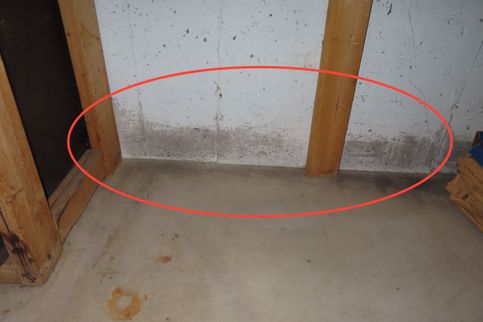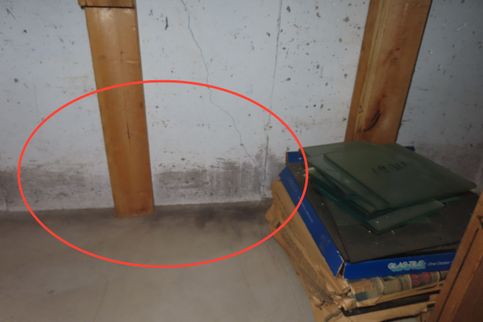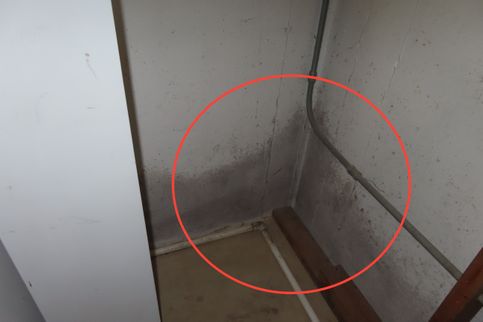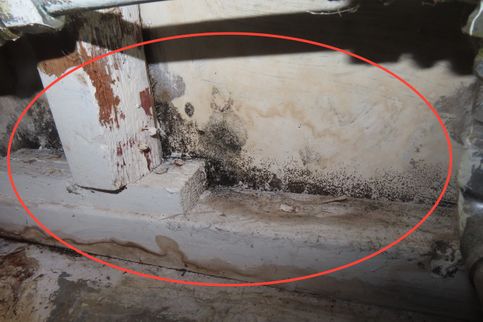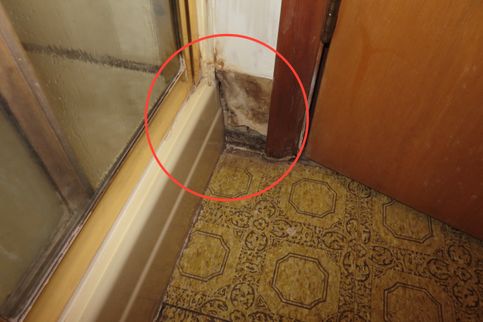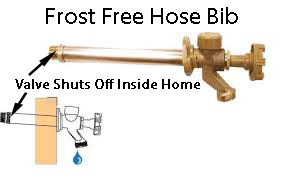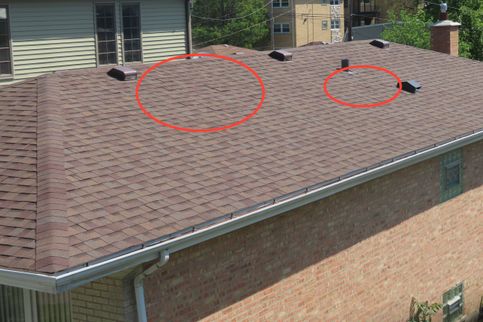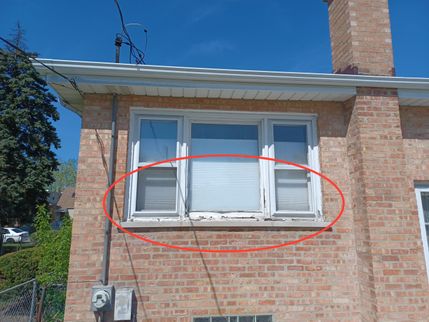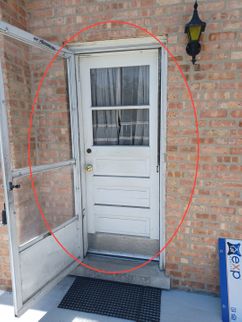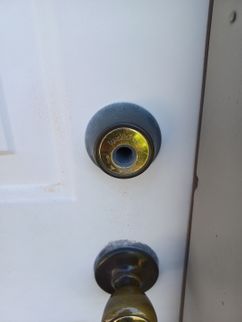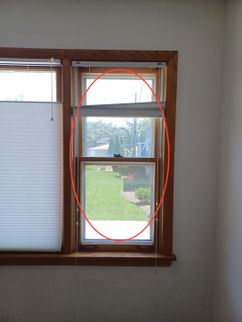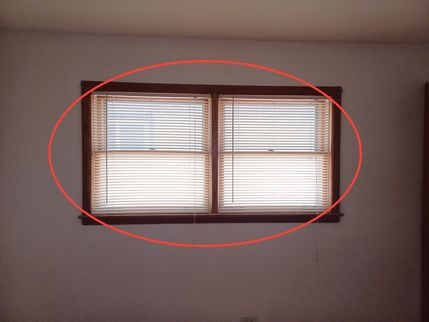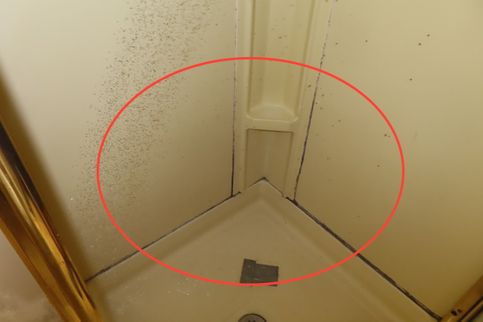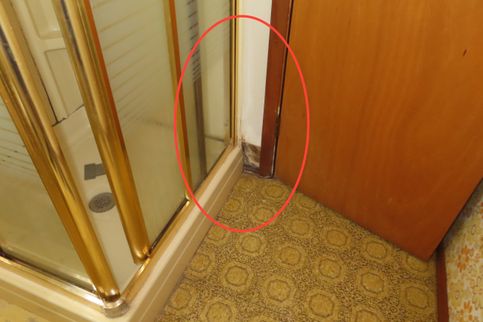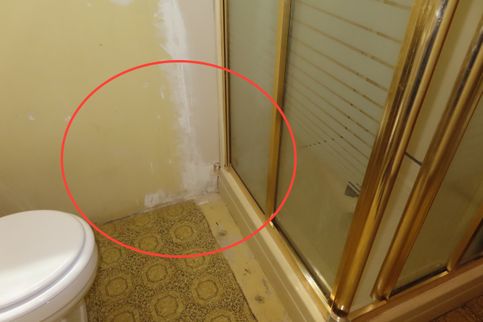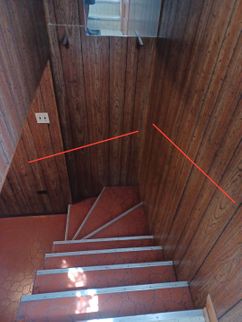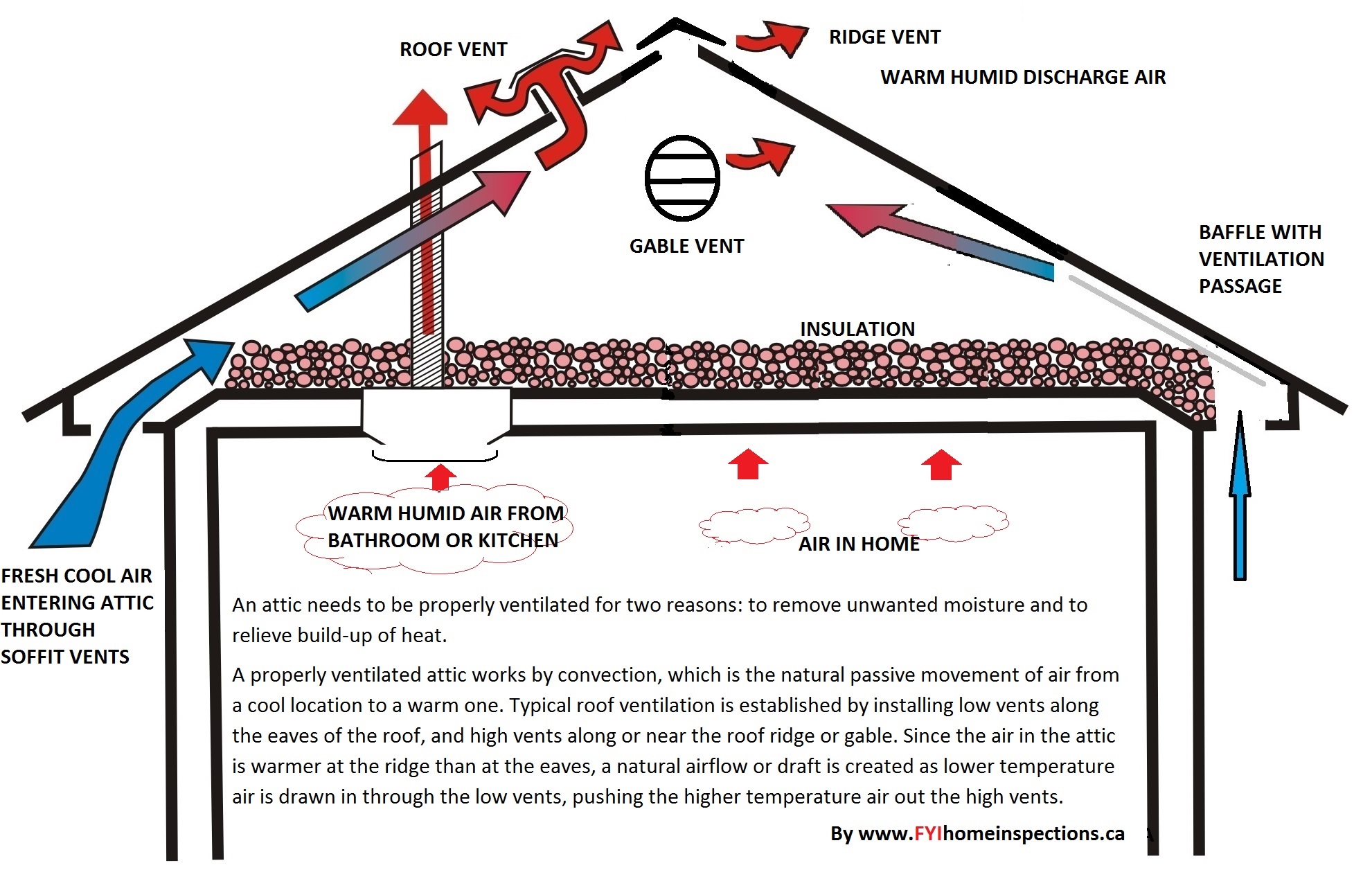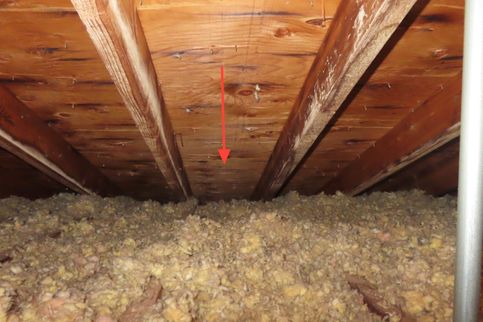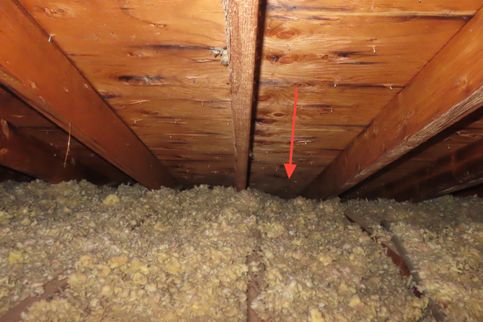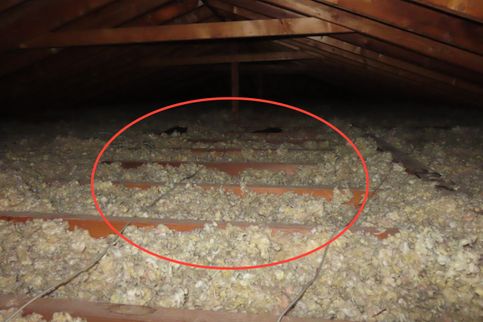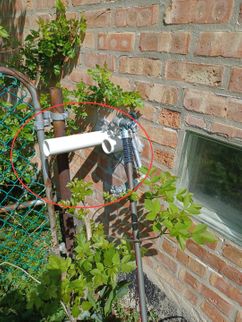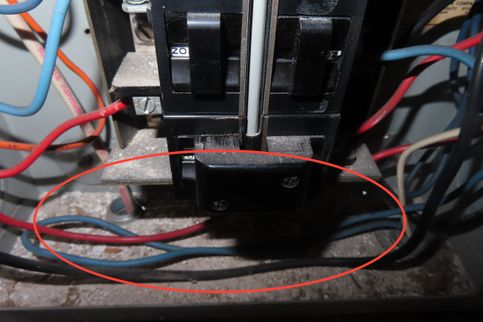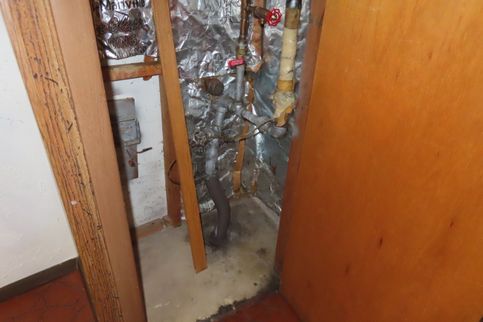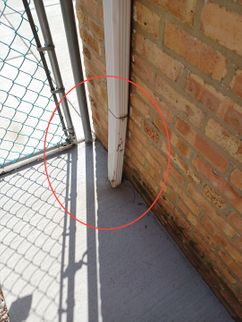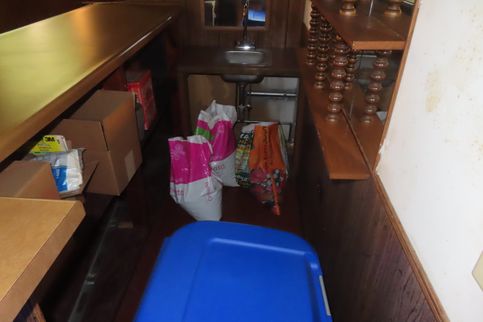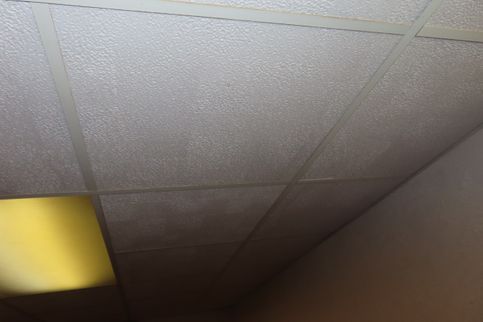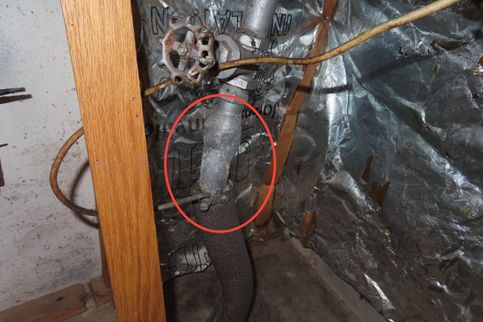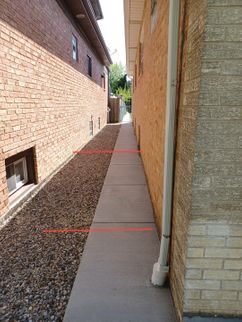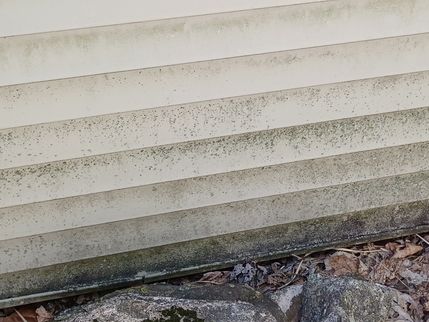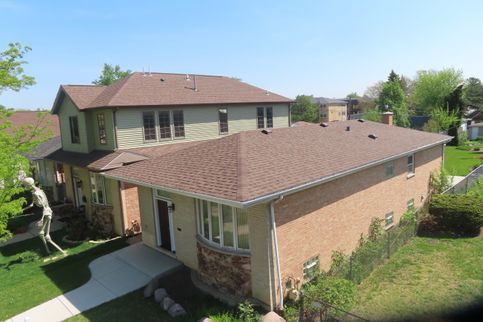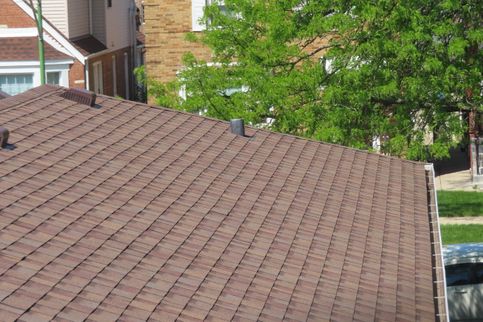IL Licensing
My Illinois home inspectors license expires on 11/30/2024.
Illinois home inspection entity licenses expire on the same date.
The purpose of this inspection is to visually examine readily accessible systems and components of a building (inspection address on contract) in accordance with this Subpart (Illinois Home Inspector License Act), using normal operating controls and opening readily accessible access panels.
How to Read This Report
The report is in a format that allows you to get to specific information quickly. Your report will have defects, concerns, general information, and things you should look into further. When looking at the report you have many different ways the information can be organized. Here are some examples of ways you can look at the report:
- HTML format: The report comes up in an internet format called HTML. I (your inspector) have tried to prioritize the information for you. For example, in the report if you click on the words "Significantly Deficient" on the left side of your screen you will see only the items I have marked as significantly deficient. My prioritization is my best guess and you should read the full report to avoid missing important information. In the HTML format you can quickly jump around the report but information has been filtered out. You may also see comments in a summary that does not have any photos but does have photos if you look at the full report. Failure to read the full report may result in damages that could have been avoided.
- PDF format: From the HTML report, at the top you have an option to print the full report via PDF. You can view the full report in PDF format on your computer. You can also print the full report and read it on paper. If you want the full report, please make sure you are printing the full report and not a summary with limited information. Reading the full report is the best way to make sure you do not miss any important information. Please note, I make every effort to include information I think is relevant. If we discussed anything that did not get into the report or if any information is different than you expected please contact me as soon as possible. I may be able to direct you to the correct location on the report or make modifications to the report so it better meets your specific needs.
- Repair Request: This is a very useful tool that can be used for many purposes. You can select items from the report to make your own list. You can include photos or not include photos. You can add your own comments to the comments and photos in the report. This allows you to go through your report and make a custom list. This can be a specific list of issues or concerns you would like addressed. Because you can add your own notes you can specify how you would prefer the issues to be taken care of. For example, for some items you could request a qualified person to repair before closing and for other items you could ask for some form of compensation to allow you to conduct repairs after closing. Agents or attorneys could generate a repair request on the clients behalf as well. Just forward your report to your representative as needed and let them know about the repair request feature. Here is a video about it: https://www.youtube.com/watch?v=IpSxVo-fiqk&t=11s.
Chapters and Sections
This report is divided into chapters. Each chapter is broken into sections. You can navigate between chapters with the click of a button on the left side margin.
Sections have descriptive information and observations.
Observation Labels
Narrative observations are colored, numbered and labeled to help you find and refer to them. Observation colors and labels used in this report are:
- Significantly Deficient:"Significantly deficient" means that in my opinion the condition is unsafe, not functional, and or it is significantly different from normal standards of practice. For all issues that are significantly deficient I strongly recommend having qualified contractors specify steps and costs to remedy the conditions. Note, there are often multiple options that impact the intrusiveness, cost, and schedule for repairs.
- Repair:Repair is used to designate anything that the inspector thinks should be repaired, replaced, or mitigated in some way. In the inspectors opinion these concerns should be addressed. These may have safety and functionality impacts. Impacts may develop or worsen in the future. There are risks associated with items that need repair or maintenance. Items might be worse than they looked at time of inspection as things change and as more information becomes available. The person purchasing the property should decide what to ask the current owner for. Please note, your inspectors opinion of who should repair which items may be offered as a courtesy and should not be considered as part of the inspection or part of the purpose and scope of the inspection.
- Due Diligence:These are observations that may require further investigation. For example the inspection does not include identification of hazardous materials. I may point out a material or product that could be hazardous. To confirm if there is a hazard would require a specialist, samples taken, a lab, and permission from the current owner. All of those actions are outside of the scope of a standard inspection. Observations in this category are typically outside the scope of a standard inspection and should not be considered complete or material to the inspection. These observations should be considered unverified.
- Maintenance:These are items that should be considered part of normal or routine home ownership activities. Items such as servicing the furnace, cleaning the gutters, or changing filters. These items are not required to be reported as part of the standard inspection. There will be similar items that are not included, not noted, and not reported. Please read manuals and product documentation for all components of the home. Please follow all manufacturers recommendations and all local, county, and state rules. Observations in this category are typically outside the scope of a standard inspection and should not be considered complete or material to the inspection.
- Improvement or Upgrade:This category is for observations that are not necessarily defects, but which could be improved for safety, efficiency, or reliability. One reason this may happen is because standards change (both written and informal standards). These conditions may be considered normal or common practice. Common conditions and common practices that are not best practice do have negative impacts. When any work is done I recommend upgrading to current standards where feasible to do so. This category may be used for items that the inspector considers to be cosmetic. Please note, these observations are outside the required standards for home inspection. I provide these comments as a courtesy. These observations should not be considered complete or material to the inspection.
- Note:Refers to aside information and or any comments elaborating on descriptions of systems or limitations to the inspection. This can include general information This the information may not apply directly to the inspected property. This information is not directly part of the property inspection and should not be considered complete. Observations in this category are often outside the scope of a standard inspection and should not be considered complete or material to the inspection.
- Inspectors Notebook:These are notes and technical information that aid in the inspection process. I may leave such information in the report for reference purposes. These notes include technical information. These notes may have information from codes and other sources. Please note, this inspection is NOT a code inspection. It is NOT a compliance inspection. Please consult with the authority having jurisdiction for rules, laws, and local requirements. This report is the inspectors opinion and recommendations. Acting as a home inspector I do not represent the authority having jurisdiction. Acting as a home inspector I have no enforcement authority.
Icons Used In This Report
 Safety Concern: Safety concerns are noted throughout the report with or without this icon. This icon is just a way for me to call your attention to specific items that have safety concerns. Many items will have safety concerns that do not get this icon added.
Safety Concern: Safety concerns are noted throughout the report with or without this icon. This icon is just a way for me to call your attention to specific items that have safety concerns. Many items will have safety concerns that do not get this icon added.
 Possible Association Issue: When inspecting one unit of a multi-family property (condominiums and townhouses), I am not inspecting the outside or common areas as part of the inspection. I do not know for sure what issues are handled by an association and which are handled by owners. I can use this icon to point out things that may be the responsibility of an association. Common areas and areas that appear to be maintained by the association or their contractors are outside the scope of the inspection. I may report some association issues, this does not obligate me to report others. All comments marked this way should be considered incomplete.
Possible Association Issue: When inspecting one unit of a multi-family property (condominiums and townhouses), I am not inspecting the outside or common areas as part of the inspection. I do not know for sure what issues are handled by an association and which are handled by owners. I can use this icon to point out things that may be the responsibility of an association. Common areas and areas that appear to be maintained by the association or their contractors are outside the scope of the inspection. I may report some association issues, this does not obligate me to report others. All comments marked this way should be considered incomplete.
 Report Update: This icon indicates a change was made to the report after initial publishing. Changes can happen because of a mistake, more information has been uncovered, or as a result of an additional visit.
Report Update: This icon indicates a change was made to the report after initial publishing. Changes can happen because of a mistake, more information has been uncovered, or as a result of an additional visit.
 Repairs Noted: This icon may be used to call your attention to repairs. For all repairs it is best for the new owner to get all available information from the current owner, including contact information for the person who did the repair. It is wise to confirm the qualifications of the contractors that did the work. This is outside of the scope of the inspection but I do recommend that you follow up regarding all past repairs.
Repairs Noted: This icon may be used to call your attention to repairs. For all repairs it is best for the new owner to get all available information from the current owner, including contact information for the person who did the repair. It is wise to confirm the qualifications of the contractors that did the work. This is outside of the scope of the inspection but I do recommend that you follow up regarding all past repairs.
 Suspect Repairs: Suspect repairs are repairs that do not appear to have been done following normal standards of practice. Repairs that are not done well are likely to cause issues in the future. For suspect repairs it is best to have these reviewed further by qualified contractors.
Suspect Repairs: Suspect repairs are repairs that do not appear to have been done following normal standards of practice. Repairs that are not done well are likely to cause issues in the future. For suspect repairs it is best to have these reviewed further by qualified contractors.
 Pest Concern: Pest concerns are noted as a courtesy and are not part of the inspection. All pest concerns should be reviewed further by a qualified pest specialist. Any information provided regarding pest activity or pest damage should be considered incomplete.
Pest Concern: Pest concerns are noted as a courtesy and are not part of the inspection. All pest concerns should be reviewed further by a qualified pest specialist. Any information provided regarding pest activity or pest damage should be considered incomplete.
 Maintenance: Maintenance considerations are noted as a courtesy and are not included as part of the inspection. Maintenance should be anticipated as part of any property ownership. The inspection is not an attempt to capture or document maintenance considerations.
Maintenance: Maintenance considerations are noted as a courtesy and are not included as part of the inspection. Maintenance should be anticipated as part of any property ownership. The inspection is not an attempt to capture or document maintenance considerations.
 Monitor: Monitor is used to indicate that in my opinion (in the inspector's opinion) the condition or conditions should be monitored. Please note, any item that I am recommending to monitor may also need repair or may develop the need for repairs at a future time.
Monitor: Monitor is used to indicate that in my opinion (in the inspector's opinion) the condition or conditions should be monitored. Please note, any item that I am recommending to monitor may also need repair or may develop the need for repairs at a future time.
 Due Diligence: Due diligence indicates something that the client should consider getting more information about. Actions you can pursue include asking the current owner, consulting with qualified specialists to review further, and getting documentation and permits. For any item I mark as due diligence I am indicating that the information I have provided is incomplete. For example, if I were to find some electrical issues and mark these as due diligence it indicates that I am concerned that once a qualified electrician starts repairs they may find additional issues I did not note in the report. This is normal and should be expected when any qualified contractor is brought in to review further, repair, or replace anything.
Due Diligence: Due diligence indicates something that the client should consider getting more information about. Actions you can pursue include asking the current owner, consulting with qualified specialists to review further, and getting documentation and permits. For any item I mark as due diligence I am indicating that the information I have provided is incomplete. For example, if I were to find some electrical issues and mark these as due diligence it indicates that I am concerned that once a qualified electrician starts repairs they may find additional issues I did not note in the report. This is normal and should be expected when any qualified contractor is brought in to review further, repair, or replace anything.
 Note: Notes are meant to convey general information. Notes can be used for many different purposes. Conditions that are outside the scope of the inspection may be listed as notes. This does not mean these are not important considerations or that no issues were found. As an example, if something is suspected of being mold but has not been confirmed or if something is suspected to contain asbestos but has not been confirmed these items may get marked as deficiencies to call attention to them. However, I may mark these items just as notes or due diligence because the deficiency is only suspected and not confirmed. It is the clients responsibility to read the entire report and pursue all issues as needed in a timely fashion. I do not take any responsibility for prioritization. You must decide what issues are important for you and your family regardless of how I classify, organize, or prioritize.
Note: Notes are meant to convey general information. Notes can be used for many different purposes. Conditions that are outside the scope of the inspection may be listed as notes. This does not mean these are not important considerations or that no issues were found. As an example, if something is suspected of being mold but has not been confirmed or if something is suspected to contain asbestos but has not been confirmed these items may get marked as deficiencies to call attention to them. However, I may mark these items just as notes or due diligence because the deficiency is only suspected and not confirmed. It is the clients responsibility to read the entire report and pursue all issues as needed in a timely fashion. I do not take any responsibility for prioritization. You must decide what issues are important for you and your family regardless of how I classify, organize, or prioritize.
🌲 Efficiency / IAQ: Efficiency and IAQ (Indoor Air Quality) indicates issues found that are likely to change seasonally. These issues impact fuel costs and also may cause condensation, water damaged, mold growth, or similar air quality issues.
Definitions And Limitations
Home Inspection: This definition is from the standard operating procedures as defined in the IL Home Inspector License Act. For all inspections I am following state laws. However, this does not prevent exclusions. Any item marked as not inspected has been removed from the scope of the inspection. When agreed upon with the client, entire systems can be removed from the inspection and common areas are excluded for any single unit inspections in a multi-family property.
"Home inspection" means the examination and evaluation of the exterior and interior components of residential real property, which includes the inspection of any 2 or more of the following components of residential real property in connection with or to facilitate the sale, lease, or other conveyance of, or the proposed sale, lease or other conveyance of, residential real property:
- heating, ventilation, and air conditioning system;
- plumbing system;
- electrical system;
- structural composition;
- foundation;
- roof;
- masonry structure; or
- any other residential real property component as established by rule.
Inspection does not include a code compliance inspection.
Throughout this report standard inspection, residential inspection, property inspection, residential property inspection, and similar terms are to be considered to have the same definition as home inspection (above).
Home Inspection Report: "Home inspection report" or "inspection report" means a written evaluation prepared and issued by a home inspector upon completion of a home inspection, which meets the standards of practice as established by the Department.
Limit Of Liability: The limit of liability regarding any questions, concerns, or issues of any kind arising from the usage of this report or reliance on any information provided as part of the inspection is limited to the fee paid for the inspection.
Client Or Customer: "Client" means a person who engages or seeks to engage the services of a home inspector for an inspection assignment.
Report Is Not Transferable: This report is not transferable. Other than the inspector, inspection company, and its representatives, only the specific party or parties listed as the customer / client can use this report for any reason.
Decorative Or Cosmetic: Ornamental; not required for the operation of the essential systems and components of a home. All decorative or cosmetic concerns are excluded from the inspection. Any comments about such items should be considered incomplete and provided only as a courtesy.
Dismantle: To take apart or remove any component, device or piece of equipment that would not be taken apart or removed by a homeowner in the course of normal and routine home owner maintenance. This inspection is visual. There will be limited or no dismantling. If any item is dismantled that does not obligate the inspector to dismantle any other item.
Further Evaluation: Examination and analysis by a qualified professional, tradesperson or service technician beyond that provided by the home inspection.
Household Appliances: Kitchen, laundry and similar appliances, whether installed or free-standing.
Inspect: To visually examine readily accessible systems and components of a building in accordance with this Subpart (Illinois Home Inspector License Act), using normal operating controls and opening readily accessible access panels.
Installed: Attached in such a manner that removal requires tools. Only items that are both readily accessible and installed are included in the inspection.
Normal Operating Controls: Devices such as, but not limited to, thermostats, switches or faucets intended to be operated by the homeowner. In general shutoff valves, overcurrent protection, and similar components are not operated during an inspection.
Readily Accessible: Available for visual inspection without requiring moving of personal property, dismantling, destructive measures, or any action that will likely involve risk to persons or property.
Readily Operable Access Panel: A panel provided for homeowner inspection and maintenance that is within normal reach, can be removed by one person, and is not sealed in place. *Note, the assessment regarding if any panel is readily operable is to be made at the sole discretion of the inspector at time of inspection.
Recreational Facilities: Spas, saunas, steam baths, swimming pools, and exercise, entertainment, athletic, playground or other similar equipment and associated accessories. Recreational facilities and accessories are not included in the inspection.
Report: To communicate in writing.
Representative Number: One component per room for multiple similar interior components, such as windows, doors and electric outlets, and one component on each side of the building for multiple similar exterior components.
Roof Drainage Systems: Components used to carry water off a roof and away from a building.
Significantly Deficient: Unsafe or not functioning.
Shut Down:
Shut Down: A state in which a system or component cannot be operated by normal controls.
Solid Fuel Burning Appliances: A hearth and fire chamber or similar prepared place in which a fire may be built and that is built in conjunction with a chimney; or a listed assembly of a fire chamber, its chimney and related factory-made parts designed for unit assembly without requiring field construction.
Structural Component: A component that supports non-variable forces or weights (dead loads) and variable forces or weights (live loads).
System: A combination of interacting or interdependent components, assembled to carry out one or more functions.
Technically Exhaustive Inspection: An investigation that involves dismantling or the extensive use of advance techniques, measurements, instruments, testing, calculations or other means. This inspection is NOT technically exhaustive.
Under-Floor Crawl Space: The area within the confines of the foundation and between the ground and the underside of the floor. Under-Floor spaces are included in the inspection only when readily accessible.
Unsafe: A condition in a system or component that poses a significant risk of personal injury or property damage during normal, day-to-day use. The risk may be due to damage, deterioration, improper installation or a change in accepted residential construction standards.
Wiring Methods: Wiring Methods: Includes identification of electrical conductors or wires such as, but not limited to, non-metallic sheathed cable (Romex), armored cable (BX) or knob and tube.
Purchasing property involves risk: The purpose of a home inspection is to provide a professional opinion of the condition of a property at a moment in time. The inspection and any resulting report do not mitigate any risk. The report must be read and understood by the client and the client must take further actions in order to benefit from the inspection. Neither an inspection nor a report can substitute for or serve as a warranty or guarantee of any kind. Home warranties can be purchased separately from insuring firms that provide this service.
A home inspection is visual and not destructive: The descriptions and observations in this report are based on a visual inspection of the structure. I inspect the aspects of the structure that can be viewed without dismantling, damaging or disfiguring and without moving furniture, personal items, or interior furnishings. Areas that are concealed, hidden or inaccessible to view are not covered by this inspection. Some systems cannot be tested during this inspection. Our procedures involve non-invasive investigation and non-destructive testing which limits the inspection.
This is not an inspection for code compliance: This inspection and report are not intended for code compliance. All houses fall out of code compliance shortly after they are built, as the codes continually change. Municipalities can choose to adopt and phase in sections of the codes on their own timetables. Only the authority having jurisdiction (typically the town) can dictate what is required. As a home inspection everything I say and report should be considered my opinion or my recommendation. I can not require anyone to comply with any specific building code or building standard.
This is just my opinion: Construction techniques and standards vary. Information in this report are my opinions. Other inspectors and qualified contractors are likely to have differing opinions. You are welcome and encouraged to seek opinions from other professionals.
SUMMARY
Significantly Deficient
- S1-3 ◾Structure:
Water Marks
- Water marks visible at time of inspection.
- There appeared to be visible mold.
Recommendations:
- I recommend a qualified carpenter to replace any water damaged building materials.
- I recommend qualified contractors to diagnose and repair any water intrusion issues as needed.
- I recommend a qualified drainage specialist to address any water intrusion.
- I recommend a mold specialist to repair, mitigate or test for air quality issues.
- S1-4 ◾Structure:
Structural Concerns
Significant concerns were noted regarding the garage structure.
Foundation:
- Water marks.
- Past repairs.
- Repairs did not appear to be working properly.
Cracking:
- Repaired cracking re-cracking.
- Water marks.
- Complementary cracking - similar cracking at opposite sides.
Moisture:
- Water damage was significant.
- Mold (suspected).
- Mold smell noted.
- If steps have been taken to address water intrusion I strongly recommend getting all paperwork, confirming the qualifications of the contractors, confirming if warrantees exists, and if warrantees are transferable.
Obstructed View:
- Paint covered many building materials that would otherwise be visible.
- Finished coverings prevented assessment.
Photos provided are representative of the issues, not all inclusive. Other issues should be anticipated.
Recommendations:
- Qualified drainage specialist.
- Qualified mold specialist.
- I recommend asking the current owner for all applicable information.
I recommend getting as much information as possible, repairing or monitoring as deemed necessary by qualified contractors. This is recommended for safety.
Repairs
- GAD-3 ◾Grounds And Drainage:
Walkways .....
Walkway issues are common. Cracking and settling occurs over time and can create drainage issues or trip hazards. Drainage should be considered when any modifications are done outside.
Walkways:
- Cracking noted.
Recommendations:
- Qualified concrete specialist.
- Qualified drainage specialist.
I recommend repairing, maintenance, improving or monitoring. This is recommended to prevent water damage and for increased safety.
- EAUAE-1 ◾Equipment And Utilities At Exterior:
Electrical Grounding
Concerns were noted regarding the electrical grounding at the service. Additional grounding issues noted inside under the Systems chapter.
Meter Cabinet:
- No ground rod.
Recommendations:
- Qualified electrician.
- I recommend further evaluation and servicing as needed.
I recommend repairing. This is recommended for safety.
- EAUAE-3 ◾Equipment And Utilities At Exterior:
Plumbing Outside .....
There were concerns noted regarding plumbing outside.
Exterior Faucets:
- Hose attached. This limits my view of issues like leaking when not in use.
- No water at valve. A valve inside may be shutoff or the faucet may need repairs.
Recommendations:
- Qualified plumber.
I recommend maintenance, repairing or replacing. This is recommended for normal function and to prevent water damage.
- ES-2 ◾Exterior Structures:
Gutters And Downspouts .....
Concerns were noted regarding the gutters and downspouts. Care should be taken related to maintenance of gutters as they represent a safety hazard for falls and other injuries.
Gutters:
- Damaged.
Downspouts:
- Not properly strapped.
Recommendations:
- Qualified roofing, gutter and downspout installer.
- I recommend professional cleaning and maintenance by a qualified gutter cleaning company.
- This cleaning should include downspouts and verification of proper function.
I recommend repairing or improving. This is recommended to prevent water damage.
- ES-4 ◾Exterior Structures:
Eaves And Soffits 🐞 Pest Concern
Concerns were noted at the soffits.
Bottom Boards:
- Holes noted.
- There may be pest activity.
Recommendations:
- Qualified pest specialist.
- Qualified carpenter.
I recommend repairing or replacing. This is recommended to prevent water damage and for normal function.
- ES-5 ◾Exterior Structures:
Roof Coverings .....
Issues were noted regarding the roof covering. Conditions reported in the inspection are representative of general conditions (not all inclusive).
Covering Condition:
- Loose or damaged shingles.
Recommendations:
- Qualified roofer.
I recommend repairing or maintenance. This is recommended to prevent water damage.
- ES-9 ◾Exterior Structures:
Windows .....
Issues were noted regarding the windows.
General Issues Found:
- Paint was damaged or at end of life.
Water Marks:
- Significant water damage noted. Hidden water damage should be expected.
💡Photos should be considered representative not all inclusive. When work is performed it is normal and common for additional issues to be uncovered.
Recommendations:
- Qualified window specialist.
I recommend maintenance, repairing or replacing. This is recommended for normal function.
- ES-10 ◾Exterior Structures:
Older Windows .....
Old windows:
- The windows were old. Many issues are common with older windows and issues can change seasonally. Energy efficiency should be a consideration. Current emergency egress and rescue standards should be considered. Current safety glass requirements should be considered. If windows are not replaced regular maintenance and repairs should be expected.
Water Marks:
- Water damage was visible.
- Significant water damage noted. Hidden water damage should be expected.
💡Photos should be considered representative not all inclusive. When work is performed it is normal and common for additional issues to be uncovered.
Recommendations:
- Qualified window specialist.
I recommend maintenance, repairing or replacing. This is recommended for normal function and for increased safety.
- ES-11 ◾Exterior Structures:
Exterior Doors
Issues Noted:
- Damaged, appeared to be forced entry.
Hardware:
- Keys were not available to test locks.
- Loose.
Screen / Storm Doors:
- Damaged.
Recommendations:
- Qualified door installer.
I recommend repairing or replacing. This is recommended for normal function.
- G-2 ◾Garages:
Exterior Doors
Deadbolt Locks:
- Damaged.
Recommendations:
- Qualified door installer.
I recommend repairing or replacing. This is recommended for normal function.
- G-3 ◾Garages:
Windows .....
Issues were noted regarding the windows.
Old windows:
- The windows were old. Many issues are common with older windows and issues can change seasonally. With older windows replacement should be considered due to energy efficiency, emergency egress and rescue standards and current safety glass requirements. If older windows are not replaced regular maintenance and repairs should be expected.
- Windows were missing.
💡Photos should be considered representative not all inclusive. When work is performed it is normal and common for additional issues to be uncovered.
Recommendations:
- Qualified window specialist.
I recommend maintenance, repairing or replacing. This is recommended for normal function.
- I1-1 ◾Interiors:
Older Windows .....
Old windows:
- The windows were old. Many issues are common with older windows and issues can change seasonally. Energy efficiency should be a consideration. Current emergency egress and rescue standards should be considered. Current safety glass requirements should be considered. If windows are not replaced regular maintenance and repairs should be expected.
💡Photos should be considered representative not all inclusive. When work is performed it is normal and common for additional issues to be uncovered.
Recommendations:
- Qualified window specialist.
I recommend maintenance, repairing or replacing. This is recommended for normal function and for increased safety.
- I1-2 ◾Interiors:
Casement Windows
There were casement windows. Casement windows have some advantages over other windows but they have more hardware which can increase the need for maintenance and repairs.
General Issues Found:
- Damaged hardware.
- Loose hardware.
💡 Issues noted should be considered representative not all inclusive.
Recommendations:
- Qualified window specialist.
I recommend getting as much information as possible, maintenance or repairing. This is recommended for normal function.
- I1-3 ◾Interiors:
Windows .....
Issues were noted regarding the windows.
General Issues Found:
- Cracked.
Accessories / Window Treatments:
- Child safety concerns were noted. Please replace for safety. These considerations are outside the scope of an inspection and are mentioned only as a courtesy.
- Window treatments are not inspected or tested as part of the inspection.
💡Photos should be considered representative not all inclusive. When work is performed it is normal and common for additional issues to be uncovered.
Recommendations:
- Qualified window specialist.
I recommend maintenance, repairing or replacing. This is recommended for normal function.
- I1-4 ◾Interiors:
Closets
Door issues:
- Difficult to open and close at multiple locations.
Recommendations:
- Qualified door installer.
I recommend repairing or replacing. This is recommended for normal function.
- I1-6 ◾Interiors:
Switches
There were concerns regarding electrical switches. Electrical defects are representative (not all inclusive).
Switches:
- Function not determined at some locations.
Recommendations:
- Qualified electrician.
- I recommend all electrical be evaluated for similar conditions and be repaired, replaced or improved as deemed necessary by a qualified electrician.
I recommend repairing or replacing. This is recommended for normal function and for safety.
- I1-7 ◾Interiors:
Exposed Electrical ❓Suspect Repairs 🛑 Safety Concern 🔍 Due Diligence
- Covers were missing.
- Electrical was exposed. This is a fire and shock risk.
💡Things like missing covers and exposed electrical are common. There are many common electrical safety issues that are easy to repair. Although electrical issues are common and easy to repair they also can cause fire or electrical shocks. Any missing covers or exposed electrical indicates nonqualified people making changes to the electrical system. During the inspection very little of the electrical system is visible for inspection. When electrical defects are found the full extent of the issue should be a consideration. Electrical defects are representative (not all inclusive).
Recommendations:
- Qualified electrician.
- I recommend asking the current owner for a list of all changes, repairs, modifications, or installations started or completed.
- I recommend all electrical be evaluated for similar conditions and be repaired, replaced or improved as deemed necessary by a qualified electrician.
I recommend repairing or replacing. This is recommended for safety.
- I1-8 ◾Interiors:
Exhaust Fans
Exhaust fan issues were found.
Full Bathrooms (With Shower Or Tub):
- Bathrooms did not have bathroom fans.
Exhaust Ductwork:
- Ducting does not make it to the outside. This causes high humidity and other issues.
💡Ventilation exhaust and flue exhaust systems can impact each other. Please only use qualified contactors to address any issues related to air quality.
Recommendations:
- Qualified insulation, ventilation and air sealing specialist.
- Qualified electrician.
- Qualified roofer.
I recommend installing, replacing, upgrading or improving. This is recommended to prevent water damage, to prevent condensation issues and for better air quality.
- I1-9 ◾Interiors:
Bathtubs With Showers
There were issues noted regarding a bathtub / shower.
Faucets:
- Leaking when tested.
Recommendations:
- Qualified plumber.
I recommend repairing. This is recommended for normal function.
- I1-10 ◾Interiors:
(GFCI) Ground Fault Circuit Interrupters .....
GFCI (Ground Fault Circuit Interrupter) protection was not working properly or missing near water sources.
General Conditions:
- GFCI protection missing or no longer working.
💡For older properties it is common to have GFCI (Ground Fault Circuit Interrupter) issues. For an electrician it is usually not difficult to add or repair GFCI protection. GFCI protection is recommended for safety near water sources and decreases the risk of electrical safety hazards. I recommend devices that make a noise when they have detected a fault. I recommend a qualified electrician to add GFCI, AFCI, and any other life saving features where it makes sense to do so. In most situations GFCI increases safety. Situations where GFCI protection may not be desirable (due to false trips) is due to medical equipment, flood / fire prevention, alarms and sensors, and food refrigeration. For all properties it is a good idea to have an electrician confirm all exterior electrical is made to be outside, that you have receptacles (outlets) and lighting where you want and upgrades to in use weather resistant covers for all exterior electrical.
Recommendations:
- Qualified electrician.
I recommend having ground fault circuit interrupters and similar protection added and replaced where it makes sense to do so for increased safety.
- I1-11 ◾Interiors:
Showers
There were issues noted regarding a shower.
Showers:
- Damaged.
- Patching or repairs.
- Repairs did not appear adequate.
- Caulk damaged.
- Water damaged around shower insert.
Faucets:
- Leaking when tested.
Recommendations:
- Qualified plumber.
I recommend repairing or replacing. This is recommended for normal function and to prevent water damage.
- I1-12 ◾Interiors:
Anti-Tip Not Working 🛑 Safety Concern
💡I check the stove for anti-tip. Some device or method of installation should prevent a child (or anyone) from tipping devices onto themselves. Ovens have an increased issue with tipping over due to the door being used for leverage. This allows toddlers to tip over ovens. I do not check other devices or appliances for this feature. Please add anti tip devices to all appliances and furniture as needed per your families and guests needs.
- Anti tip feature was not working or not installed.
- This is a child safety risk.
- Typically adding an anti tip device is not difficult.
Recommendations:
- Qualified appliance specialist.
I recommend repairing or replacing. This is recommended for child safety.
- I1-13 ◾Interiors:
Windows .....
Issues were noted regarding the windows.
General Issues Found:
- Stuck shut.
💡Photos should be considered representative not all inclusive. When work is performed it is normal and common for additional issues to be uncovered.
Recommendations:
- Qualified window specialist.
I recommend maintenance, repairing or replacing. This is recommended for normal function.
- I1-14 ◾Interiors:
Stairs
Concerns were noted regarding the stairs.
Stair Treads:
- Inconsistent tread depth noted. Trip hazard.
Recommendations:
- Qualified carpenter.
I recommend maintenance, repairing or replacing. This is recommended for normal function and for increased safety.
- I1-15 ◾Interiors:
Railings Missing
Railing were missing.
Recommendations:
- Qualified carpenter.
I recommend installing, repairing or replacing railings at all locations as needed for increased safety.
- S1-1 ◾Structure:
Structural Concerns
Significant concerns were noted regarding the structure.
Moisture:
- Condensation marks. Ventilation issues.
- Mold mediation (suspected).
Insulation:
- Recommending adding insulation.
Photos provided are representative of the issues, not all inclusive. Other issues should be anticipated.
Recommendations:
- 💡When structural concerns are noted please use contractors who have access to a qualified structural engineer for consultation if needed.
- Qualified mold specialist.
- Qualified roofer.
- Qualified specialist.
I recommend repairing or improving as deemed necessary by qualified contractors. This is recommended for safety.
- S1-2 ◾Structure:
Insulation Ventilation And Air Sealing
💡Insulation, ventilation, and air sealing should be addressed together. Repairing one without addressing the others may have unintended consequences. Poor quality air sealing, insulation, and ventilation are common. This does impact energy usage and fuel costs. These issues can also lead to condensation and water damage. Pictures should be considered representative not all inclusive. I recommend using qualified contractors for this type of work and making sure that all three get addressed together.
Attic:
- Soffit baffles not visible. Ventilation may be blocked or not properly installed.
Insulation At Access:
- Not insulated. Causes condensation seasonally.
Insulation:
- Limited insulation. There was insulation but not very much by todays standards.
Ventilation:
- Baffles missing not visible. Baffles are used to prevent insulation from blocking ventilation.
Water Marks:
- Water marks visible at time of inspection.
Recommendations:
- Qualified insulation, ventilation and air sealing specialist.
I recommend maintenance, improving or upgrading. This is recommended to prevent water damage.
- S-3 ◾Systems:
Venting And Exhaust
💡Venting and exhaust are important because this is how we get rid of products of combustion and moisture. Venting and exhaust can be difficult to diagnose because most of what I am commenting on is not visible. Venting and exhaust can be difficult to assess because installations can very greatly depending on the appliances connected.
PVC Venting:
- End covers not installed to prevent pests and other types of intrusions.
Recommendations:
- Qualified heating and cooling specialist.
- I recommend confirming the qualifications of contractors who have done work on the property.
I recommend repairing. This is recommended for safety.
- S-4 ◾Systems:
Blower Equipment
Concerns were noted regarding heating and air conditioning equipment.
Condensate:
- Condensate line was not properly installed - no air gap.
Recommendations:
- Qualified heating and cooling specialist.
I recommend repairing, improving or upgrading. This is recommended for increased safety.
- S-5 ◾Systems:
Heating Equipment
Concerns were noted regarding heating equipment.
Equipment Condition:
- Equipment was dirty.
- Evidence of pest activity.
Recommendations:
- Qualified heating specialist.
I recommend maintenance or repairing. This is recommended for normal function and for increased safety.
- S-7 ◾Systems:
Electrical Grounding 🛑 Safety Concern
Grounding and bonding has changed over time. Grounding and bonding is complicated. If a qualified electrician disagrees with my assessment of the electrical system this may be because they are using an older standard than me or it could be because they know more about bonding and grounding. I recommend further review and maintenance, repair or upgrade as deemed necessary by a qualified electrician. Electrical is often out of date and less safe than what is currently required. Grounding and bonding is both complicated and also difficult to visually confirm because of normal obstructed views.
Grounding At Meter:
- No ground found at electrical meter. This is common but outdated. I recommend upgrading grounding and bonding to current standards for increased safety.
Connections To Metal Water Pipe:
- Connection present but not within 5 feet of the water service.
Recommendations:
- Qualified electrician.
- For all properties, when any electrical work is being done, I recommend asking the electrician to assess bonding, grounding, panels, and other electrical. Upgrades to the electrical to conform to current standards should be considered for increased safety.
I recommend upgrading, improving or repairing. This is recommended for increased safety.
- S-10 ◾Systems:
Accessed Service Equipment And Disconnects 🛑 Safety Concern
There were concerns regarding the electrical service equipment.
Panel Issues:
- Past expected life. Panel was old and out dated. Expected life of electrical equipment is not well established. The most consistent standard appears to be 40 years. For any panel that is approaching or past 40 years of age I recommend review by a qualified electrician for increased safety. This is due to the age of the equipment and changing safety standards.
- Conduit from outside not properly sealed. I recommend duct seal (product approved for this purpose).
- Dirty.
- Attached to foundation wall.
Overcurrent Protection (Breakers):
- No available slots. This can increase cost to repair, change, or add to the electrical system.
Double Pole Double Slot (240 Volt Breakers):
- Oversized breakers for air conditioner condenser unit. Fire safety risk.
Recommendations:
- Qualified electrician.
I recommend replacing or repairing. This is recommended for safety.
- S-12 ◾Systems:
Plumbing Distribution
Concerns were noted regarding the plumbing distribution.
Copper Distribution:
- Dissimilar metals touching. This causes corrosion and leaks.
- Repairs did not appear to be up to normal professional standards.
Galvanized Distribution:
- Dissimilar metals touching. This causes corrosion and leaks.
💡 When any plumbing repairs or modifications are done it is important that some qualified person check and as needed repair electrical grounding and bonding. This is recommended for all plumbing repairs or modifications.
Recommendations:
- Qualified plumber.
I recommend repairing or replacing. This is recommended for normal function and to prevent water damage.
- S-14 ◾Systems:
Gas Piping / Distribution
The following concerns were noted related to the gas piping on the property.
Steel Pipe (Black Pipe / Galvanized):
- Pipes were painted. This is recommended to protect from rust but can obstruct my view for inspection.
- Galvanized pipe was used. Black pipe is best practice. Galvanized can flake off and damage valves. I recommend a qualified plumber to proactively replace with black pipe or monitoring and replacing if any gas components get damaged by flaking.
Recommendations:
- Qualified plumber.
I recommend repairing or replacing. This is recommended for normal function and for safety.
- S-16 ◾Systems:
Plumbing Supply
💡Water meters are typically the property of the utility and only installed when there is a public water supply. The supply and main shutoff should be maintained to prevent leaks and to allow for servicing. It is also needed in case of emergency. This equipment should be kept accessible and clear of debris.
Plumbing Main Meter:
- Not located, check with utility. The utility may have a flat rate for the property and no meter.
Recommendations:
- Qualified plumber.
- I recommend asking the current owner for all applicable information.
I recommend upgrading or improving. This is recommended for normal function and to meet your needs.
- S-17 ◾Systems:
Drains Waste And Vents
Issues were noted regarding the plumbing system.
Cleanout:
- Water marks visible.
Drain Piping:
- Water marks.
- Repairs did not appear adequate.
- Temporary repairs noted.
Drain waste and vents use gravity (and sometimes pumps) to remove waste and waste water from the property. There are issues with plumbing systems that only cause an issue in high winds or when the system is under heavy usage. Plumbing defects, may go undetected due to symptoms being intermittent. When repairs are being done often additional conditions become known and also require repair.
Recommendations:
- Qualified plumber.
I recommend repairing or replacing. This is recommended to prevent further water damage.
Due Diligence
- ES-1 ◾Exterior Structures:
Underground Downspout Extensions .....
Underground discharges and extensions are not visible and not inspected. Maintenance should be done regularly for gutters, downspouts, and all underground extensions or plumbing. There are devices that can be installed to help keep debris out of the gutters. There are devices that can be installed to help keep debris out of the underground plumbing.
Recommendations:
- I recommend asking the current owner where underground plumbing discharges.
- I recommend asking current owner for all maintenance records.
- I recommend having gutters, downspouts, and underground plumbing cleaned and maintained.
- Cleaning should include verification of proper function.
I recommend maintenance and monitoring. This is recommended to prevent water damage.
- S1-5 ◾Structure:
Obstructed View
Conditions at time of inspection limited access.
Recommendations:
- I recommend inspecting further when conditions permit.
- I recommend monitoring and normal maintenance.
- I recommend further review by qualified contractors as needed.
- S1-6 ◾Structure:
Asbestos Warning 🛑 Safety Concern 🔍 Due Diligence
Asbestos was commonly used in buildings until around 1986. There are health risks and health concerns regarding asbestos. There were building materials that may contain asbestos. This can be confirmed with testing. Anything related to asbestos or any hazardous material is outside of the scope of a standard inspection. If remodeling is done, a strict safety protocol should be adhered to to limit or prevent the spread of construction dust.
May Contain Asbestos:
- Textured or "popcorn" finish.
- Ceiling tiles.
- Pipe insulation.
Recommendations:
- Qualified hazardous materials specialist.
- I recommend a qualified party to test materials if asbestos is suspected.
- Until tested I recommend treating the materials as having asbestos in them.
- For more information please see the following links: https://www.asbestos.com/products/ and https://www.epa.gov/asbestos
- S-8 ◾Systems:
Smoke Detectors
💡I do not test smoke detectors, alarms, or similar devices. For most properties it is best to replace the smoke detectors and carbon monoxide detectors with new ones on move in.
Smoke Detector Recommendations:
- For all properties I recommend replacing the detectors to meet current manufacturer installation instructions.
- Photo-electric type alarms are recommended at locations like kitchens to prevent false alarms.
- I recommend cleaning regularly per manufacturers recommendations.
- I recommend the 10 year type batteries. No more replacing batteries for the detectors.
- Replace batteries twice per year (if not upgraded to the 10 year type).
- Test regularly, twice per year.
- Interconnected detectors may be more effective.
- For more information see the following link from NFPA Information.
Recommended Locations:
- At least one per structure.
- At least one per floor.
- At least one within 20 feet of all bedrooms on each floor.
- At least one in each bedroom or sleeping area.
The death rate per 1,000 reported home fires was more than twice as high in homes that did not have any working smoke alarms compared to the rate in homes with working smoke alarms (13.0 deaths vs. 5.8 deaths per 1,000 fires). Per NFPA.org
Recommendations:
- I recommend replacing detectors on move in and every 5 to 10 years following manufacturers instructions.
- I recommend replacing with modern devices (interconnected and 10 year batteries).
- S-9 ◾Systems:
Carbon Monoxide Detectors
💡I do not test carbon monoxide detectors, alarms, or similar devices.
Carbon Monoxide Detector Recommendations:
- For all properties I recommend replacing the detectors to meet current manufacturer installation instructions.
- I recommend cleaning regularly per manufacturers recommendations.
- Test regularly, twice per year.
- Interconnected detectors may be more effective.
- For more information see the following link from NFPA Information.
Recommended Locations:
- At least one per floor.
- At least one within 10 feet of all bedrooms on each floor.
Recommendations:
- I recommend replacing detectors on move in and every 5 to 10 years following manufacturers instructions.
- I recommend replacing with modern devices (interconnected and 10 year batteries).
- S-11 ◾Systems:
Plumbing Supply Lead 🛑 Safety Concern 🔍 Due Diligence
The water service pipe that connects the water distribution system to the utility appeared to be made of lead. Utilities often take steps to minimize the lead in the water (please confirm this with the utility). Replacing the service is an option but is generally not considered to be cost effective. There are also services that can test your water for you.
When the water main for the plumbing system is lead, this adds an electrical concern as well. A lead water main may be able to provide a ground source for the electrical system, however these are often old connections. The corrosion that forms can prevent this connection from providing a proper ground for the electrical system.
Recommendations:
- I strongly recommend using a filter that removes lead for all drinking and cooking water.
- I recommend consulting a qualified plumber or utility regarding precautions you can take for lead safety.
- You can reduce your risk by running the water for a few minutes before using tap water for drinking or cooking.
- In general with a tank water heater you should not use the hot water for cooking or drinking, the water heater can concentrate contaminants.
- If you are concerned about your drinking water other options to consider are water delivery services and bulk water purchase at the grocery store.
- There are services that will come to your location for testing and less expensive options where you collect the water in their container for testing.
- For more information please check with the US EPA: https://www.epa.gov/ground-water-and-drinking-water
- I recommend a qualified electrician to check the grounding and bonding for the property.
- These recommendations are for increased safety and to improve water quality.
- AI-2 ◾Additional Information:
Personal Items Obstructed View
- Personal items blocked access to some areas.
- Personal items are not inspected.
Recommendations:
- I recommend inspecting further when conditions permit.
- I recommend monitoring and normal maintenance.
- AI-3 ◾Additional Information:
Create Repair List - Instructions
This report (by default) is formatted in HTML. This format is powerful and allows people to find what they are looking for quickly. This format can be confusing when compared to paper. If you have trouble finding what you are looking for you might want to use one of the PDF formats. You can make a PDF of the entire report or just the summary. The buttons for this are at the very top of the HTML report.
You can also make your own lists with just the items you want included. We call these repair lists. The repair request button is also at the top with the PDF report options.
You can do all of the following making your own repair list:
- You can include only the items you select for your custom reports.
- In your custom report you can add specific photos from the report. Unselected photos will not be included and photos from items you did not select will also not show up in your custom report.
- You can add your own comments to each item in your custom report. This may include your own notes, notes from a contractor, estimate information, or your specific requests such as specific repairs desired or some form of credit request.
- Please see the following video for instructions: https://www.youtube.com/watch?v=IpSxVo-fiqk
Maintenance Items
- GAD-1 ◾Grounds And Drainage:
Grading Flat
Grade issues can cause pooling water and water intrusion.
Grading:
- Flat. This may cause water intrusion.
Recommendations:
- Qualified drainage specialist.
I recommend repairing or improving the drainage to prevent water intrusion.
- GAD-2 ◾Grounds And Drainage:
Vegetation
Trees and vegetation can damage the property. Vegetation near the property prevents access for inspection. Utilities can be damaged by vegetation and trees.
Vegetation:
- There was vegetation near the property.
Recommendations:
- Qualified arborist (tree specialist).
- Qualified drainage specialist.
I recommend trimming vegetation near the property and improving drainage as needed. This is recommended to prevent damage to the property.
- EAUAE-2 ◾Equipment And Utilities At Exterior:
Gas Service And Main Shutoff 🛑 Safety Concern
Concerns were noted regarding the gas supply.
Service Conditions:
- Rusty components. I recommend a qualified plumber to check the plumbing and paint with paint made for rusty metal to prevent leaks.
Recommendations:
- Qualified plumber.
I recommend maintenance. This is recommended for increased safety.
- ES-3 ◾Exterior Structures:
Chimneys And Flues
💡 Interiors of chimneys and flues are not visible and not inspected as part of the property inspection. Level 2 chimney inspection should be part of every real estate transfer per the National Fire Protection Association. A Level 2 inspection is an in-depth inspection that can find safety issues not visible during the inspection.
Flashings:
- Sealed with tar / caulk.
Recommendations:
- Qualified roofer.
- Qualified mason.
I recommend maintenance, improving and monitoring. This is recommended to prevent water damage.
- ES-7 ◾Exterior Structures:
Masonry Siding Description .....
Brick:
- Regular maintenance is recommended to prevent water intrusion.
- I recommend monitoring and repairing as part of regular maintenance.
- G-1 ◾Garages:
Siding Conditions
💡Exterior wall coverings are often referred to as siding or cladding.
Damage And Installation Issues:
- Discoloration, likely an indications of water intrusion.
Recommendations:
- Qualified siding specialist.
I recommend maintenance or repairing. This is recommended to prevent water damage.
- S-2 ◾Systems:
Forced Air Distinguishing Characteristics 📝 Note 🔍 Due Diligence 🌲 Efficiency / IAQ 👁🗨 Monitor
- Forced air heating systems use air flow via ducting to distribute heating.
- Forced air heating systems typically accommodate cooling systems as well with a shared distribution system.
Recommendations:
- I recommend asking the current owner for all documentation regarding the installation, maintenance, and repairs.
- I recommend cleaning per manufacturers recommendations.
- I recommend having unit cleaned if maintenance has not been done recently or can not be confirmed.
- S-6 ◾Systems:
AC Split System Distinguishing Characteristics
- A split system is common for air conditioning.
- A split system can have a dedicated blower or it can share a blower with a heating system.
Recommendations:
- I recommend monitoring and normal maintenance.
- I recommend cleaning per manufacturers recommendations.
- I recommend having unit cleaned if maintenance has not been done recently or can not be confirmed.
- S-13 ◾Systems:
Sump / Ejector / Drainage Pumps
Pump Access:
- Sewage pit was not sealed. I recommend a qualified plumber to review further and repair or replace for health and safety.
- Cover was rusted.
Recommendations:
- Qualified plumber.
- For all pumps and equipment I recommend getting and reading the manufacturers documentation.
- I recommend getting maintenance and service history.
- I recommend having the equipment maintained per manufacturers recommendations.
I recommend repairing and upgrading. This is recommended to prevent water damage.
📚FULL REPORT
◾Grounds And Drainage
Surface Drainage
Walkways
Driveways
Patios
Retaining Walls
Crawlspace Vents And Wells
Window Wells
Egress / Basement Wells
Fencing
◾Introduction
Inspection Conditions
Contract Sent: Before Inspection
Contract Signed: Before Inspection
Property Type: Single Family (Detached)
Year of Construction (Estimated): Pre 1973 (1972)
Temperature (Fahrenheit, Estimated): 70 - 80
Weather: Mild Conditions
Aluminum Wiring Warning
From around 1964 to around 1972 we were using aluminum solid conductor wire in many electrical systems. During a standard property inspection electrical switch and outlet covers are not removed. Most wire is not visible and not inspected. There are many different kinds of wire and identification is not always possible or accurate. For more information about aluminum wiring please consult a qualified electrician. Please note, only "solid conductor aluminum branch circuit wiring" is considered a reportable concern, other aluminum wiring may be properly installed and properly sized. Information regarding aluminum wiring is available from the CPSC (Consumer Products Safety Commission) at the following link Repairing Aluminum Wiring. Here is an in depth discussion of aluminum wiring and its issues.
Recommendations:
For additional protection in any electrical system I recommend installing AFCI breakers on circuits where feasible. AFCI protection can be helpful for older wiring and concealed electrical defects. AFCI devices detect arcing conditions that may result from solid conductor aluminum branch circuit wiring. Please note, if solid conductor aluminum branch circuit wiring is discovered at any time this can impact insurance options, costs, and claims. Please note, not all aluminum wiring installations are a concern. The safety of aluminum wiring depends both on the alloy of the aluminum and the installation. Please consult with a qualified electrician for more information if you have any concerns regarding the electrical system.
Lead Warning
Construction prior to 1978 most likely contains paints with lead. Paints may not cause any issues when properly maintained so the paint does not become "friable" or air-borne. Keeping coverings (walls, floors, ceilings, windows, doors, and woodwork) well painted can minimize exposure to the lead paints. This is for safety reasons. Proper cleanup before, during, and just after any repairs is important for safety. For additional information please see the following link from the EPA: Lead Information
Recommendations:
- For all properties I recommend maintaining coverings and paint.
- If you are concerned about hazardous materials please consult with a specialist for proper identification and mitigation options.
- When scraping loose paint be sure to clean properly and take safety precautions.
- I recommend using contractors trained in lead safety.
- It is recommended that old painted building materials be removed and properly disposed of as opposed to sanding panted coverings.
Asbestos Warning
Asbestos was commonly used in buildings until around 1986. The presence of asbestos should be assumed in properties prior to that time frame. Common products that may contain asbestos include "popcorn" coverings, textured coverings, acoustic tiles, linoleum, vinyl, siding, vermiculite, heat duct insulation / tape, pipe insulation and paints. Asbestos products are not usually considered to be a problem as long as they are in sound condition and not friable. When materials are damaged or when remodeling is performed, strict safety protocols should be followed to limit or prevent the spread of asbestos. There is no way to guarantee that any property is free of asbestos (even newer properties).
- I may or may not note materials of concern.
- Material identification is limited outside the scope of the inspection.
- Testing (not part of the inspection) is necessary if you want to confirm that any material does or does not contain asbestos.
- This comment and any comments regarding any hazardous material is provided as a courtesy and should be considered incomplete.
- The presence of asbestos can not be determined without lab testing.
- All comments regarding asbestos are outside the scope of the inspection.
- I do not have any hazardous materials certifications or credentials.
- If there is a forced air system and you are concerned about asbestos I strongly recommend professional duct cleaning, sanitizing, and chemical sealing from the inside. I recommend doing this coordinated with a professional commercial cleaning of the property and any forced air systems, equipment, and components.
- You should contact a hazardous materials specialist regarding any such concerns.
- For more information please see the following: https://www.asbestos.com/products/ and https://www.epa.gov/asbestos
Recommendations:
- For all properties I recommend maintaining coverings and paint.
- If you are concerned about hazardous materials please consult with a specialist for proper identification and mitigation options.
◾Grounds And Drainage
Surface Drainage
Grading And Surface Drainage: Flat (Both Sides)
Vegetation: Concerns Noted
Drainage Conditions And Systems: Not Visible Below Grade
Vegetation
Trees and vegetation can damage the property. Vegetation near the property prevents access for inspection. Utilities can be damaged by vegetation and trees.
Vegetation:
- There was vegetation near the property.
Recommendations:
- Qualified arborist (tree specialist).
- Qualified drainage specialist.
I recommend trimming vegetation near the property and improving drainage as needed. This is recommended to prevent damage to the property.
Walkways
Walkways: Issues Noted
Walkways .....
Walkway issues are common. Cracking and settling occurs over time and can create drainage issues or trip hazards. Drainage should be considered when any modifications are done outside.
Walkways:
- Cracking noted.
Recommendations:
- Qualified concrete specialist.
- Qualified drainage specialist.
I recommend repairing, maintenance, improving or monitoring. This is recommended to prevent water damage and for increased safety.
Driveways
Driveways: Not Inspected (No Driveway Found)
Patios
Patios: Normal Conditions
Retaining Walls
Retaining Walls: None Found
Crawlspace Vents And Wells
Crawlspace Vent Covers: None Found
Window Wells
Window Wells: No Windows Below Grade
Egress / Basement Wells
Egress / Basement Wells: None Found
Fencing
Fencing: Not Inspected
◾Equipment And Utilities At Exterior
Electrical
Equipment Outside: Normal Conditions Noted
Service (Drop / Lateral, Entrance Conductors, Cables, And Raceways): Overhead, Concerns Noted
Electrical Service Grounding: Overhead Service (Grounding Not Visible)
Exterior Electrical: 2 Outlets (Tested And Reset)
Electrical Grounding
Concerns were noted regarding the electrical grounding at the service. Additional grounding issues noted inside under the Systems chapter.
Meter Cabinet:
- No ground rod.
Recommendations:
- Qualified electrician.
- I recommend further evaluation and servicing as needed.
I recommend repairing. This is recommended for safety.
Plumbing
Main Fuel Shutoff Locations: Outside - Side, Concerns Noted
Exterior Plumbing: Concerns Noted, 2 Faucets
Plumbing Outside .....
There were concerns noted regarding plumbing outside.
Exterior Faucets:
- Hose attached. This limits my view of issues like leaking when not in use.
- No water at valve. A valve inside may be shutoff or the faucet may need repairs.
Recommendations:
- Qualified plumber.
I recommend maintenance, repairing or replacing. This is recommended for normal function and to prevent water damage.
Gas Service And Main Shutoff 🛑 Safety Concern
Concerns were noted regarding the gas supply.
Service Conditions:
- Rusty components. I recommend a qualified plumber to check the plumbing and paint with paint made for rusty metal to prevent leaks.
Recommendations:
- Qualified plumber.
I recommend maintenance. This is recommended for increased safety.
Cooling
Equipment Outside: Normal Conditions Noted
Cooling Equipment: Normal Conditions Noted
Manufacturers: Rheem
Year Of Manufacture (Estimated): Less Than 15 Years Old (2021)
Cooling Capacity (Estimated): Thousands Of BTU's (30 = 2.5 Ton)
Max Breaker: Per Nameplate (30)
◾Exterior Structures
🛐Roof Coverings
Methods Used To Inspect The Roof: Inspected From (Ground), Tools Used (Camera And Zoom)
Roof Covering Description: Asphalt
Roof Covering Condition: Issues Noted
Roof Drainage Systems: Downspouts Underground, Issues Noted
Flashings, Skylights, And Roof Penetrations: Obstructed View
Chimneys And Flues: Issues Noted
Eaves, Soffits, And Fascias: Issues Noted
Gutters And Downspouts .....
Concerns were noted regarding the gutters and downspouts. Care should be taken related to maintenance of gutters as they represent a safety hazard for falls and other injuries.
Gutters:
- Damaged.
Downspouts:
- Not properly strapped.
Recommendations:
- Qualified roofing, gutter and downspout installer.
- I recommend professional cleaning and maintenance by a qualified gutter cleaning company.
- This cleaning should include downspouts and verification of proper function.
I recommend repairing or improving. This is recommended to prevent water damage.
Eaves And Soffits 🐞 Pest Concern
Concerns were noted at the soffits.
Bottom Boards:
- Holes noted.
- There may be pest activity.
Recommendations:
- Qualified pest specialist.
- Qualified carpenter.
I recommend repairing or replacing. This is recommended to prevent water damage and for normal function.
Roof Coverings .....
Issues were noted regarding the roof covering. Conditions reported in the inspection are representative of general conditions (not all inclusive).
Covering Condition:
- Loose or damaged shingles.
Recommendations:
- Qualified roofer.
I recommend repairing or maintenance. This is recommended to prevent water damage.
Underground Downspout Extensions .....
Underground discharges and extensions are not visible and not inspected. Maintenance should be done regularly for gutters, downspouts, and all underground extensions or plumbing. There are devices that can be installed to help keep debris out of the gutters. There are devices that can be installed to help keep debris out of the underground plumbing.
Recommendations:
- I recommend asking the current owner where underground plumbing discharges.
- I recommend asking current owner for all maintenance records.
- I recommend having gutters, downspouts, and underground plumbing cleaned and maintained.
- Cleaning should include verification of proper function.
I recommend maintenance and monitoring. This is recommended to prevent water damage.
Chimneys And Flues
💡 Interiors of chimneys and flues are not visible and not inspected as part of the property inspection. Level 2 chimney inspection should be part of every real estate transfer per the National Fire Protection Association. A Level 2 inspection is an in-depth inspection that can find safety issues not visible during the inspection.
Flashings:
- Sealed with tar / caulk.
Recommendations:
- Qualified roofer.
- Qualified mason.
I recommend maintenance, improving and monitoring. This is recommended to prevent water damage.
Wall Coverings
Description Of Exterior Wall Covering: Masonry, Aluminum / Vinyl Siding
Exterior Wall Covering: Masonry (Brick, Rock And Mortar)
Exterior Wall Flashing And Trim: Normal Conditions
Foundation Visible At Exterior: Limited View
Penetrations: Normal Conditions
Masonry Siding Description .....
Brick:
- Regular maintenance is recommended to prevent water intrusion.
- I recommend monitoring and repairing as part of regular maintenance.
Lapped Siding Description .....
Lapped vinyl or aluminum siding was installed. Lapped siding is a popular, cost effective, low maintenance option. Lapped siding is not as durable as other options. In general lapped siding is low cost to install and low cost to maintain. Lapped siding typically lasts around 20 to 40 years depending on several factors.
Decks And Balconies
Attached Decks And Balconies: None Found
Porches And Stoops
Attached Porches And Stoops: Normal Conditions Noted
Attached Steps And Stairs: Normal Conditions Noted
Stairs
Attached Steps And Stairs: Normal Conditions Noted
Railings: Present Where Expected
Doors And Windows
Exterior Doors: Conditions Noted
Windows: Concerns Noted, Old Windows
Doorbell: Working
Windows .....
Issues were noted regarding the windows.
General Issues Found:
- Paint was damaged or at end of life.
Water Marks:
- Significant water damage noted. Hidden water damage should be expected.
💡Photos should be considered representative not all inclusive. When work is performed it is normal and common for additional issues to be uncovered.
Recommendations:
- Qualified window specialist.
I recommend maintenance, repairing or replacing. This is recommended for normal function.
Older Windows .....
Old windows:
- The windows were old. Many issues are common with older windows and issues can change seasonally. Energy efficiency should be a consideration. Current emergency egress and rescue standards should be considered. Current safety glass requirements should be considered. If windows are not replaced regular maintenance and repairs should be expected.
Water Marks:
- Water damage was visible.
- Significant water damage noted. Hidden water damage should be expected.
💡Photos should be considered representative not all inclusive. When work is performed it is normal and common for additional issues to be uncovered.
Recommendations:
- Qualified window specialist.
I recommend maintenance, repairing or replacing. This is recommended for normal function and for increased safety.
Outbuildings
Outbuildings: None Found
◾Garages
Attached Garage
Attached Garages: None
Garage (Freestanding)
Detached Garages: Not Inspected (Access Prevented)
Overhead Doors: Not Tested Not Accessed
Overhead Door Operations: Not Tested Not Accessed
Exterior Doors: Issues Noted, Not Tested Not Accessed
Garage Exterior: Concerns Noted (Siding Conditions)
Garage Heating And Plumbing: Not Accessed
Electrical: Not Inspected (Obstructed View)
Windows: Concerns Noted
Windows .....
Issues were noted regarding the windows.
Old windows:
- The windows were old. Many issues are common with older windows and issues can change seasonally. With older windows replacement should be considered due to energy efficiency, emergency egress and rescue standards and current safety glass requirements. If older windows are not replaced regular maintenance and repairs should be expected.
- Windows were missing.
💡Photos should be considered representative not all inclusive. When work is performed it is normal and common for additional issues to be uncovered.
Recommendations:
- Qualified window specialist.
I recommend maintenance, repairing or replacing. This is recommended for normal function.
Siding Conditions
💡Exterior wall coverings are often referred to as siding or cladding.
Damage And Installation Issues:
- Discoloration, likely an indications of water intrusion.
Recommendations:
- Qualified siding specialist.
I recommend maintenance or repairing. This is recommended to prevent water damage.
◾Interiors
Rooms
Walls, Ceilings And Floors: Normal Conditions Noted
Interior Doors: Normal Conditions Noted
Windows: Old Windows, Casement Windows, Concerns Noted
Electrical: Switch Issues
Closets: Closet Concerns Noted
Countertops And Cabinets: Normal Conditions Noted
Older Windows .....
Old windows:
- The windows were old. Many issues are common with older windows and issues can change seasonally. Energy efficiency should be a consideration. Current emergency egress and rescue standards should be considered. Current safety glass requirements should be considered. If windows are not replaced regular maintenance and repairs should be expected.
💡Photos should be considered representative not all inclusive. When work is performed it is normal and common for additional issues to be uncovered.
Recommendations:
- Qualified window specialist.
I recommend maintenance, repairing or replacing. This is recommended for normal function and for increased safety.
Casement Windows
There were casement windows. Casement windows have some advantages over other windows but they have more hardware which can increase the need for maintenance and repairs.
General Issues Found:
- Damaged hardware.
- Loose hardware.
💡 Issues noted should be considered representative not all inclusive.
Recommendations:
- Qualified window specialist.
I recommend getting as much information as possible, maintenance or repairing. This is recommended for normal function.
Windows .....
Issues were noted regarding the windows.
General Issues Found:
- Cracked.
Accessories / Window Treatments:
- Child safety concerns were noted. Please replace for safety. These considerations are outside the scope of an inspection and are mentioned only as a courtesy.
- Window treatments are not inspected or tested as part of the inspection.
💡Photos should be considered representative not all inclusive. When work is performed it is normal and common for additional issues to be uncovered.
Recommendations:
- Qualified window specialist.
I recommend maintenance, repairing or replacing. This is recommended for normal function.
Switches
There were concerns regarding electrical switches. Electrical defects are representative (not all inclusive).
Switches:
- Function not determined at some locations.
Recommendations:
- Qualified electrician.
- I recommend all electrical be evaluated for similar conditions and be repaired, replaced or improved as deemed necessary by a qualified electrician.
I recommend repairing or replacing. This is recommended for normal function and for safety.
Exposed Electrical ❓Suspect Repairs 🛑 Safety Concern 🔍 Due Diligence
- Covers were missing.
- Electrical was exposed. This is a fire and shock risk.
💡Things like missing covers and exposed electrical are common. There are many common electrical safety issues that are easy to repair. Although electrical issues are common and easy to repair they also can cause fire or electrical shocks. Any missing covers or exposed electrical indicates nonqualified people making changes to the electrical system. During the inspection very little of the electrical system is visible for inspection. When electrical defects are found the full extent of the issue should be a consideration. Electrical defects are representative (not all inclusive).
Recommendations:
- Qualified electrician.
- I recommend asking the current owner for a list of all changes, repairs, modifications, or installations started or completed.
- I recommend all electrical be evaluated for similar conditions and be repaired, replaced or improved as deemed necessary by a qualified electrician.
I recommend repairing or replacing. This is recommended for safety.
Bathrooms
Bathrooms: Inspected (3)
Toilets: Flushed
Faucets / Sinks: Working, No Active Leaking
Showers / Bathtubs: Issues Noted (Bathtubs With Showers, Showers)
Electrical: GFCI Issues
Bathroom Fans - Mechanical Ventilation: Issues Noted
Cabinets And Countertops: Normal Conditions Noted
Walls Ceilings And Floors: Normal Conditions Noted
Doors: Opened Closed And Latched
Windows: Glass Block
Glass In Bathrooms: Type Of Glass Not Confirmed
Exhaust Fans
Exhaust fan issues were found.
Full Bathrooms (With Shower Or Tub):
- Bathrooms did not have bathroom fans.
Exhaust Ductwork:
- Ducting does not make it to the outside. This causes high humidity and other issues.
💡Ventilation exhaust and flue exhaust systems can impact each other. Please only use qualified contactors to address any issues related to air quality.
Recommendations:
- Qualified insulation, ventilation and air sealing specialist.
- Qualified electrician.
- Qualified roofer.
I recommend installing, replacing, upgrading or improving. This is recommended to prevent water damage, to prevent condensation issues and for better air quality.
(GFCI) Ground Fault Circuit Interrupters .....
GFCI (Ground Fault Circuit Interrupter) protection was not working properly or missing near water sources.
General Conditions:
- GFCI protection missing or no longer working.
💡For older properties it is common to have GFCI (Ground Fault Circuit Interrupter) issues. For an electrician it is usually not difficult to add or repair GFCI protection. GFCI protection is recommended for safety near water sources and decreases the risk of electrical safety hazards. I recommend devices that make a noise when they have detected a fault. I recommend a qualified electrician to add GFCI, AFCI, and any other life saving features where it makes sense to do so. In most situations GFCI increases safety. Situations where GFCI protection may not be desirable (due to false trips) is due to medical equipment, flood / fire prevention, alarms and sensors, and food refrigeration. For all properties it is a good idea to have an electrician confirm all exterior electrical is made to be outside, that you have receptacles (outlets) and lighting where you want and upgrades to in use weather resistant covers for all exterior electrical.
Recommendations:
- Qualified electrician.
I recommend having ground fault circuit interrupters and similar protection added and replaced where it makes sense to do so for increased safety.
Showers
There were issues noted regarding a shower.
Showers:
- Damaged.
- Patching or repairs.
- Repairs did not appear adequate.
- Caulk damaged.
- Water damaged around shower insert.
Faucets:
- Leaking when tested.
Recommendations:
- Qualified plumber.
I recommend repairing or replacing. This is recommended for normal function and to prevent water damage.
Kitchens
Kitchens: 1
Plumbing: Working - No Active Leaking
Disposal: Not Found
Dishwasher: None Installed
Cabinets And Countertops: Normal Conditions Noted
Electrical: Outlets Near Water Tested And Reset
Cooktop Exhaust Fan: Working
Cooktop / Oven: Cooktop And Oven, Anti-Tip (Device Tipped - Child Safety Risk)
Refrigerator: Working (Cool By Touch)
Microwave: None Installed None Built-In
Walls Ceilings And Floors: Normal Conditions Noted
Doors / Windows: Window Issues
Accessories: Not Inspected
Anti-Tip Not Working 🛑 Safety Concern
💡I check the stove for anti-tip. Some device or method of installation should prevent a child (or anyone) from tipping devices onto themselves. Ovens have an increased issue with tipping over due to the door being used for leverage. This allows toddlers to tip over ovens. I do not check other devices or appliances for this feature. Please add anti tip devices to all appliances and furniture as needed per your families and guests needs.
- Anti tip feature was not working or not installed.
- This is a child safety risk.
- Typically adding an anti tip device is not difficult.
Recommendations:
- Qualified appliance specialist.
I recommend repairing or replacing. This is recommended for child safety.
Windows .....
Issues were noted regarding the windows.
General Issues Found:
- Stuck shut.
💡Photos should be considered representative not all inclusive. When work is performed it is normal and common for additional issues to be uncovered.
Recommendations:
- Qualified window specialist.
I recommend maintenance, repairing or replacing. This is recommended for normal function.
Stairs And Railings
Stairs And Railings: Concerns Noted, Railings Missing
Electrical: No Issues Found
Laundry Areas
Laundry Areas: 1
Plumbing: Sink Tested, No Active Leaking
Washer Connections: Tested, No Active Leaking Found
Dryer Connections: Metal / Rigid Vent
Electrical: Normal Conditions Noted
Exhaust Fan: None Noted
Cabinets / Countertops: None Found
Laundry Chute: None Found
◾Structure
🦇Attic Spaces
Attic Access: 1 Attic Space Accessed
Methods Used To Inspect Attic: From Entrance
Roof Structure Visible: Dimensional Lumber (2x6), Issues Noted
Ceiling Structure: Obstructed View
Electrical: No Issues Found
Plumbing: Plumbing Vent Visible
Insulation: Blown
Ventilation: Obstructed View, Issues Noted
Wall Structure: Obstructed View
Structural Concerns
Significant concerns were noted regarding the structure.
Moisture:
- Condensation marks. Ventilation issues.
- Mold mediation (suspected).
Insulation:
- Recommending adding insulation.
Photos provided are representative of the issues, not all inclusive. Other issues should be anticipated.
Recommendations:
- 💡When structural concerns are noted please use contractors who have access to a qualified structural engineer for consultation if needed.
- Qualified mold specialist.
- Qualified roofer.
- Qualified specialist.
I recommend repairing or improving as deemed necessary by qualified contractors. This is recommended for safety.
Insulation Ventilation And Air Sealing
💡Insulation, ventilation, and air sealing should be addressed together. Repairing one without addressing the others may have unintended consequences. Poor quality air sealing, insulation, and ventilation are common. This does impact energy usage and fuel costs. These issues can also lead to condensation and water damage. Pictures should be considered representative not all inclusive. I recommend using qualified contractors for this type of work and making sure that all three get addressed together.
Attic:
- Soffit baffles not visible. Ventilation may be blocked or not properly installed.
Insulation At Access:
- Not insulated. Causes condensation seasonally.
Insulation:
- Limited insulation. There was insulation but not very much by todays standards.
Ventilation:
- Baffles missing not visible. Baffles are used to prevent insulation from blocking ventilation.
Water Marks:
- Water marks visible at time of inspection.
Recommendations:
- Qualified insulation, ventilation and air sealing specialist.
I recommend maintenance, improving or upgrading. This is recommended to prevent water damage.
🗼Below Grade Spaces
Foundation Description: Basement
Methods Used To Inspect Under Floor Space: Walked Basement
Structural Components, Foundations, And Framing: Obstructed View, Concerns Noted (Water Marks)
Probed Structural Components: Damaged Components (Water Damage)
Floor Structure: Obstructed View (Finished Materials)
Wall Structure: Obstructed View (Finished Materials)
Ceiling Structure: Obstructed View (Finished Materials), Beams (Metal)
Windows In Below Grade Spaces: None Below Grade
Water Marks
- Water marks visible at time of inspection.
- There appeared to be visible mold.
Recommendations:
- I recommend a qualified carpenter to replace any water damaged building materials.
- I recommend qualified contractors to diagnose and repair any water intrusion issues as needed.
- I recommend a qualified drainage specialist to address any water intrusion.
- I recommend a mold specialist to repair, mitigate or test for air quality issues.
Structural Concerns
Significant concerns were noted regarding the garage structure.
Foundation:
- Water marks.
- Past repairs.
- Repairs did not appear to be working properly.
Cracking:
- Repaired cracking re-cracking.
- Water marks.
- Complementary cracking - similar cracking at opposite sides.
Moisture:
- Water damage was significant.
- Mold (suspected).
- Mold smell noted.
- If steps have been taken to address water intrusion I strongly recommend getting all paperwork, confirming the qualifications of the contractors, confirming if warrantees exists, and if warrantees are transferable.
Obstructed View:
- Paint covered many building materials that would otherwise be visible.
- Finished coverings prevented assessment.
Photos provided are representative of the issues, not all inclusive. Other issues should be anticipated.
Recommendations:
- Qualified drainage specialist.
- Qualified mold specialist.
- I recommend asking the current owner for all applicable information.
I recommend getting as much information as possible, repairing or monitoring as deemed necessary by qualified contractors. This is recommended for safety.
Asbestos Warning 🛑 Safety Concern 🔍 Due Diligence
Asbestos was commonly used in buildings until around 1986. There are health risks and health concerns regarding asbestos. There were building materials that may contain asbestos. This can be confirmed with testing. Anything related to asbestos or any hazardous material is outside of the scope of a standard inspection. If remodeling is done, a strict safety protocol should be adhered to to limit or prevent the spread of construction dust.
May Contain Asbestos:
- Textured or "popcorn" finish.
- Ceiling tiles.
- Pipe insulation.
Recommendations:
- Qualified hazardous materials specialist.
- I recommend a qualified party to test materials if asbestos is suspected.
- Until tested I recommend treating the materials as having asbestos in them.
- For more information please see the following links: https://www.asbestos.com/products/ and https://www.epa.gov/asbestos
❄️Insulation And Ventilation
Insulation And Vapor Retarders: Not Visible In Finished Areas
Ventilation: Not Visible
Insulation Description: Obstructed View
Vapor Retarders - Description: Not Visible In Finished Spaces
Mechanical Ventilation: See Other Sections (Kitchens, Bathrooms)
Additions
Additions: There did not appear to be any additions.
◾Systems
Fireplaces
Fireplaces: None
🔥Heating
Heating Methods And Distinguishing Characteristics: Forced Air
Installed Heating Equipment: Working, Concerns Noted (Blower Systems, Heating Systems)
Visible Heating Components Inspected: Fans
Fans Registers
Registers
Heating Components Not Applicable Or Not Accessed: Heat Exchangers, Heating Elements, Radiators And Convectors
Energy Sources: Gas
Visible Vent Systems, Flues And Chimneys: PVC, Concerns Noted
Manufacturers: American Weathermakers
Year Of Manufacture (Estimated): Less Than 20 Years Old (2009)
Filters: Disposable
Capacity (Estimated): Thousands Of BTU's (60-70)
Venting And Exhaust
💡Venting and exhaust are important because this is how we get rid of products of combustion and moisture. Venting and exhaust can be difficult to diagnose because most of what I am commenting on is not visible. Venting and exhaust can be difficult to assess because installations can very greatly depending on the appliances connected.
PVC Venting:
- End covers not installed to prevent pests and other types of intrusions.
Recommendations:
- Qualified heating and cooling specialist.
- I recommend confirming the qualifications of contractors who have done work on the property.
I recommend repairing. This is recommended for safety.
Blower Equipment
Concerns were noted regarding heating and air conditioning equipment.
Condensate:
- Condensate line was not properly installed - no air gap.
Recommendations:
- Qualified heating and cooling specialist.
I recommend repairing, improving or upgrading. This is recommended for increased safety.
Forced Air Distinguishing Characteristics 📝 Note 🔍 Due Diligence 🌲 Efficiency / IAQ 👁🗨 Monitor
- Forced air heating systems use air flow via ducting to distribute heating.
- Forced air heating systems typically accommodate cooling systems as well with a shared distribution system.
Recommendations:
- I recommend asking the current owner for all documentation regarding the installation, maintenance, and repairs.
- I recommend cleaning per manufacturers recommendations.
- I recommend having unit cleaned if maintenance has not been done recently or can not be confirmed.
❄️Cooling
Cooling Equipment Distinguishing Characteristics : Split System
Installed Cooling Equipment: Appeared To Be Working
Through-Wall Cooling: None Found
Energy Sources: Electric 240 Volt
AC Split System Distinguishing Characteristics
- A split system is common for air conditioning.
- A split system can have a dedicated blower or it can share a blower with a heating system.
Recommendations:
- I recommend monitoring and normal maintenance.
- I recommend cleaning per manufacturers recommendations.
- I recommend having unit cleaned if maintenance has not been done recently or can not be confirmed.
⚡Electrical
Service (Drop / Lateral, Entrance Conductors, Cables, And Raceways): Overhead
Main Disconnect Locations: At Main Panel
Main Disconnects And Interior Of Service Equipment: One Main Panel Inspected, Concerns Noted
Service Grounding: Visible Components (Inside Panel), Concerns Noted
Overcurrent Protection Devices: Breakers
Conductors Visible: Aluminum (Noted, Not At Branch Circuits), Copper
Wiring Methods Noted: Metal Conduit / Raceways
Service Amperage Rating (Not Measured): 100 Amps
Service Voltage Rating (Not Measured): 120 / 240 Split Single Phase
Subpanel Locations: None Found
Subpanel Interior Components: None Found
Smoke Detectors: Not Found (Absence)
Carbon Monoxide Detectors: Standard Recommendations
Ground Fault Circuit Interrupters: Issues Noted In Other Sections
Installed Lighting Fixtures: Normal Conditions Noted
Switches: Issues Noted In Other Sections
Receptacles (Outlets): Normal Conditions Noted
Low Voltage, Accessories, And Audio Video: Not Inspected
Electrical Grounding 🛑 Safety Concern
Grounding and bonding has changed over time. Grounding and bonding is complicated. If a qualified electrician disagrees with my assessment of the electrical system this may be because they are using an older standard than me or it could be because they know more about bonding and grounding. I recommend further review and maintenance, repair or upgrade as deemed necessary by a qualified electrician. Electrical is often out of date and less safe than what is currently required. Grounding and bonding is both complicated and also difficult to visually confirm because of normal obstructed views.
Grounding At Meter:
- No ground found at electrical meter. This is common but outdated. I recommend upgrading grounding and bonding to current standards for increased safety.
Connections To Metal Water Pipe:
- Connection present but not within 5 feet of the water service.
Recommendations:
- Qualified electrician.
- For all properties, when any electrical work is being done, I recommend asking the electrician to assess bonding, grounding, panels, and other electrical. Upgrades to the electrical to conform to current standards should be considered for increased safety.
I recommend upgrading, improving or repairing. This is recommended for increased safety.
Accessed Service Equipment And Disconnects 🛑 Safety Concern
There were concerns regarding the electrical service equipment.
Panel Issues:
- Past expected life. Panel was old and out dated. Expected life of electrical equipment is not well established. The most consistent standard appears to be 40 years. For any panel that is approaching or past 40 years of age I recommend review by a qualified electrician for increased safety. This is due to the age of the equipment and changing safety standards.
- Conduit from outside not properly sealed. I recommend duct seal (product approved for this purpose).
- Dirty.
- Attached to foundation wall.
Overcurrent Protection (Breakers):
- No available slots. This can increase cost to repair, change, or add to the electrical system.
Double Pole Double Slot (240 Volt Breakers):
- Oversized breakers for air conditioner condenser unit. Fire safety risk.
Recommendations:
- Qualified electrician.
I recommend replacing or repairing. This is recommended for safety.
Smoke Detectors
💡I do not test smoke detectors, alarms, or similar devices. For most properties it is best to replace the smoke detectors and carbon monoxide detectors with new ones on move in.
Smoke Detector Recommendations:
- For all properties I recommend replacing the detectors to meet current manufacturer installation instructions.
- Photo-electric type alarms are recommended at locations like kitchens to prevent false alarms.
- I recommend cleaning regularly per manufacturers recommendations.
- I recommend the 10 year type batteries. No more replacing batteries for the detectors.
- Replace batteries twice per year (if not upgraded to the 10 year type).
- Test regularly, twice per year.
- Interconnected detectors may be more effective.
- For more information see the following link from NFPA Information.
Recommended Locations:
- At least one per structure.
- At least one per floor.
- At least one within 20 feet of all bedrooms on each floor.
- At least one in each bedroom or sleeping area.
The death rate per 1,000 reported home fires was more than twice as high in homes that did not have any working smoke alarms compared to the rate in homes with working smoke alarms (13.0 deaths vs. 5.8 deaths per 1,000 fires). Per NFPA.org
Recommendations:
- I recommend replacing detectors on move in and every 5 to 10 years following manufacturers instructions.
- I recommend replacing with modern devices (interconnected and 10 year batteries).
Carbon Monoxide Detectors
💡I do not test carbon monoxide detectors, alarms, or similar devices.
Carbon Monoxide Detector Recommendations:
- For all properties I recommend replacing the detectors to meet current manufacturer installation instructions.
- I recommend cleaning regularly per manufacturers recommendations.
- Test regularly, twice per year.
- Interconnected detectors may be more effective.
- For more information see the following link from NFPA Information.
Recommended Locations:
- At least one per floor.
- At least one within 10 feet of all bedrooms on each floor.
Recommendations:
- I recommend replacing detectors on move in and every 5 to 10 years following manufacturers instructions.
- I recommend replacing with modern devices (interconnected and 10 year batteries).
🚰Plumbing
Water Main Shutoff Location: Inside - Lowest Level, Gate Valve, Issues Noted
Water Main Interior Supply: Working
Water Main Interior Supply Piping Materials: Lead
Check Valve At Plumbing Supply: None Found
Plumbing Distribution: Galvanized, Copper, Issues Noted
Interior Fixtures And Faucets: Issues Noted In Other Sections
Drain, Waste, And Vent Piping Materials: Metal
Drain, Waste, And Vent: All Fixtures Tested, Issues Noted
Drainage Sumps, Sump Pumps, And Related Piping: Pits Noted (1), Concerns Noted (Ejector / Sump / Pit)
Floor Drains: Floor Drain Present
Fuel Main Shutoff Locations: Outside - Side
Fuel Storage And Fuel Distribution Systems: Black Pipe, Galvanized, Issues Noted (Gas Distribution)
Plumbing Distribution
Concerns were noted regarding the plumbing distribution.
Copper Distribution:
- Dissimilar metals touching. This causes corrosion and leaks.
- Repairs did not appear to be up to normal professional standards.
Galvanized Distribution:
- Dissimilar metals touching. This causes corrosion and leaks.
💡 When any plumbing repairs or modifications are done it is important that some qualified person check and as needed repair electrical grounding and bonding. This is recommended for all plumbing repairs or modifications.
Recommendations:
- Qualified plumber.
I recommend repairing or replacing. This is recommended for normal function and to prevent water damage.
Gas Piping / Distribution
The following concerns were noted related to the gas piping on the property.
Steel Pipe (Black Pipe / Galvanized):
- Pipes were painted. This is recommended to protect from rust but can obstruct my view for inspection.
- Galvanized pipe was used. Black pipe is best practice. Galvanized can flake off and damage valves. I recommend a qualified plumber to proactively replace with black pipe or monitoring and replacing if any gas components get damaged by flaking.
Recommendations:
- Qualified plumber.
I recommend repairing or replacing. This is recommended for normal function and for safety.
Plumbing Supply
💡Water meters are typically the property of the utility and only installed when there is a public water supply. The supply and main shutoff should be maintained to prevent leaks and to allow for servicing. It is also needed in case of emergency. This equipment should be kept accessible and clear of debris.
Plumbing Main Meter:
- Not located, check with utility. The utility may have a flat rate for the property and no meter.
Recommendations:
- Qualified plumber.
- I recommend asking the current owner for all applicable information.
I recommend upgrading or improving. This is recommended for normal function and to meet your needs.
Drains Waste And Vents
Issues were noted regarding the plumbing system.
Cleanout:
- Water marks visible.
Drain Piping:
- Water marks.
- Repairs did not appear adequate.
- Temporary repairs noted.
Drain waste and vents use gravity (and sometimes pumps) to remove waste and waste water from the property. There are issues with plumbing systems that only cause an issue in high winds or when the system is under heavy usage. Plumbing defects, may go undetected due to symptoms being intermittent. When repairs are being done often additional conditions become known and also require repair.
Recommendations:
- Qualified plumber.
I recommend repairing or replacing. This is recommended to prevent further water damage.
Plumbing Supply Lead 🛑 Safety Concern 🔍 Due Diligence
The water service pipe that connects the water distribution system to the utility appeared to be made of lead. Utilities often take steps to minimize the lead in the water (please confirm this with the utility). Replacing the service is an option but is generally not considered to be cost effective. There are also services that can test your water for you.
When the water main for the plumbing system is lead, this adds an electrical concern as well. A lead water main may be able to provide a ground source for the electrical system, however these are often old connections. The corrosion that forms can prevent this connection from providing a proper ground for the electrical system.
Recommendations:
- I strongly recommend using a filter that removes lead for all drinking and cooking water.
- I recommend consulting a qualified plumber or utility regarding precautions you can take for lead safety.
- You can reduce your risk by running the water for a few minutes before using tap water for drinking or cooking.
- In general with a tank water heater you should not use the hot water for cooking or drinking, the water heater can concentrate contaminants.
- If you are concerned about your drinking water other options to consider are water delivery services and bulk water purchase at the grocery store.
- There are services that will come to your location for testing and less expensive options where you collect the water in their container for testing.
- For more information please check with the US EPA: https://www.epa.gov/ground-water-and-drinking-water
- I recommend a qualified electrician to check the grounding and bonding for the property.
- These recommendations are for increased safety and to improve water quality.
Sump / Ejector / Drainage Pumps
Pump Access:
- Sewage pit was not sealed. I recommend a qualified plumber to review further and repair or replace for health and safety.
- Cover was rusted.
Recommendations:
- Qualified plumber.
- For all pumps and equipment I recommend getting and reading the manufacturers documentation.
- I recommend getting maintenance and service history.
- I recommend having the equipment maintained per manufacturers recommendations.
I recommend repairing and upgrading. This is recommended to prevent water damage.
Gate Valves
💡 All older valves and specifically gate valves are likely to leak or not work properly when you try to operate them. As part of the inspection shutoff valves are not tested or operated. This equipment should be kept accessible, clear of debris, clear of personal items and maintained regularly.
Recommendations:
- Qualified plumber.
- I recommend replacing old valves, gate valves, and saddle valves with new better valves when any other plumbing work is being performed.
I recommend replacing, upgrading, improving, maintenance or monitoring. This is recommended to prevent water damage.
🚿Water Heating
Water Heating Equipment Description: 1 Tank (40 Gallons)
Water Heating Energy Sources: Gas
Water Heating Equipment: Working
Vent Systems, Flues, And Chimneys: Metal
Manufacturers: Bradford White
Year Of Manufacture (Estimated): Less Than 10 Years Old (2022)
Water Heater Cold Shut-Off: Shutoff Present On Cold Line
Tank Water Heater Description 🔧 Maintenance 👁🗨 Monitor
- For all appliances I recommend reading the manual and performing regular maintenance.
- For all water heating equipment you should be carful regarding the water temperature.
- When a water heater is set too high it can become a scald risk.
- To prevent scald risks we usually tell people to set the maximum temperature at showers to about 120 degrees Fahrenheit.
- When the temperature is too low this can impact performance and even water quality.
- Please check and adjust temperature settings for your families safety.
- Tank systems can last longer with regular maintenance such as emptying any debris from the tank regularly (see manual).
◾Additional Information
Inspection Wrap Up
Client Present: Yes
Occupancy: Personal Items Noted
Stove / Oven Settings: Confirmed Off
Thermostat Settings: Agent Addressed
Doors Locked: Agent Addressed
Fireplace Dampers: Not Applicable
Personal Items Obstructed View
- Personal items blocked access to some areas.
- Personal items are not inspected.
Recommendations:
- I recommend inspecting further when conditions permit.
- I recommend monitoring and normal maintenance.
Thank You! 📝 Note
Thank you for coming to the inspection. It was a pleasure talking to you about the property. Please contact me if you have questions at any time.
Next Steps
Create Repair List - Instructions
This report (by default) is formatted in HTML. This format is powerful and allows people to find what they are looking for quickly. This format can be confusing when compared to paper. If you have trouble finding what you are looking for you might want to use one of the PDF formats. You can make a PDF of the entire report or just the summary. The buttons for this are at the very top of the HTML report.
You can also make your own lists with just the items you want included. We call these repair lists. The repair request button is also at the top with the PDF report options.
You can do all of the following making your own repair list:
- You can include only the items you select for your custom reports.
- In your custom report you can add specific photos from the report. Unselected photos will not be included and photos from items you did not select will also not show up in your custom report.
- You can add your own comments to each item in your custom report. This may include your own notes, notes from a contractor, estimate information, or your specific requests such as specific repairs desired or some form of credit request.
- Please see the following video for instructions: https://www.youtube.com/watch?v=IpSxVo-fiqk
Limitations
The report does not address environmental hazards, for example: Lead-based paint, Radon, Carbon monoxide, Asbestos, Mold, or Other similar environmental hazards
The report does not address: Wood Destroying Insects, Wood Destroying Organisms, or Other pest / pest related issues
The report does not address subterranean systems or components (operational or nonoperational), for example: Sewage disposal, Water quality, Water supply, Fuel delivery, Fuel storage
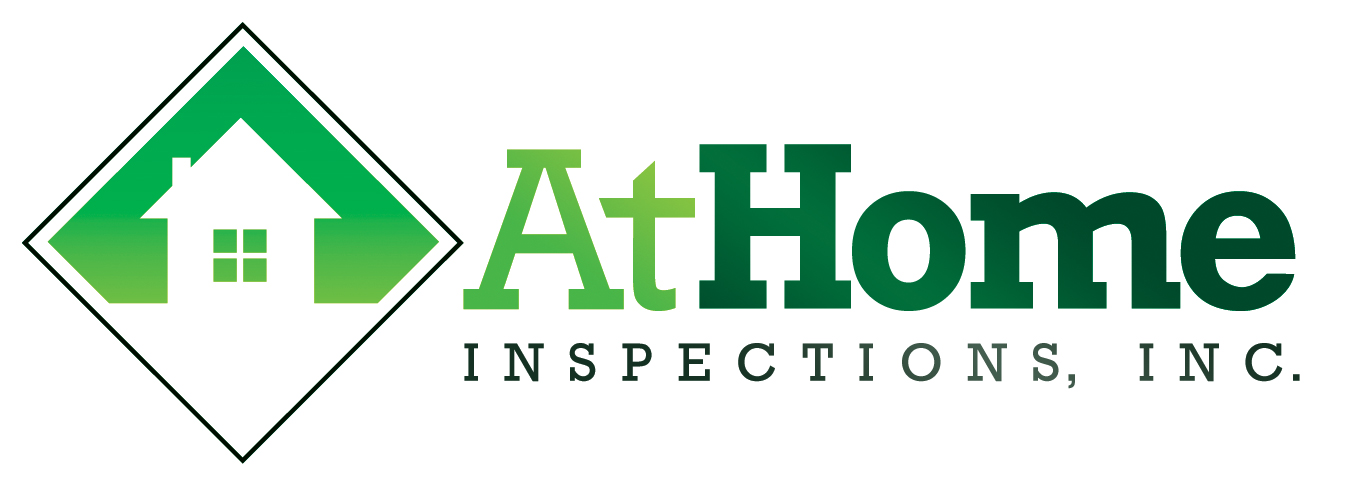
.jpg)


